

























































































































































































































































































































































































































































































































































































































































































































































































































































































































































































































































































































































































































































































































































































































































































































































Within a secluded archipelago in the bountiful Red Sea, a story thousands of years old is waiting to be told. Born from the stars of the infinite sky above and the colorful reef below, Nujuma, a Ritz-Carlton Reserve carries on the traditions of those who traveled across uncharted territory to discover pristine natural beauty, rich cultural heritage and flavors as vivid as the sea itself. Surrounded by crystal-clear water and soft white sand, Nujuma is an unspoiled sanctuary where exploration unveils a constellation of unforgettable experiences.
Accessed by chartered boat or seaplane, Nujuma features 63 overwater and beach villas, offering one-to-three-bedroom accommodation, spacious living areas and private pools overlooking the sea, while each enjoys the services of a dedicated personal host, who will take care of every detail and guide guests through all the enriching experiences this destination has to offer, including five unique culinary concepts and a tranquil spa.
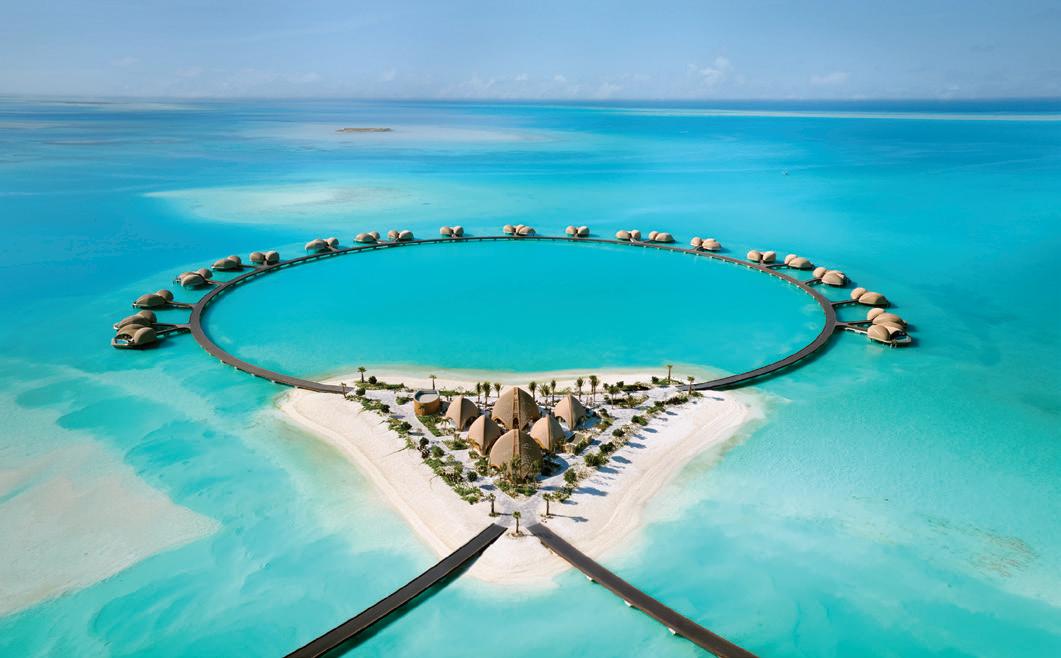

Ever since her breakout role in Euphoria, it seems like everyone is talking about Sydney Sweeney. Lex Martin meets her to find out why.
How Markus Klinko swapped a harp for a camera and became an acclaimed photographer, working with the likes of Beyoncé.
How a charity fashion event billed as frivolous fun became The Battle of Versailles — a landmark event for fashion.

RM 65-01
Skeletonised automatic winding calibre
60-hour power reserve (±10%)
Baseplate and bridges in grade 5 titanium
Split-seconds chronograph
Function selector and rapid winding mechanism
Variable-geometry rotor
Case in blue Quartz TPT®
Eighteen Radar
Twenty Objects of Desire
Twenty Two Art & Design
Twenty Six Jewellery
Thirty Four Timepieces
Fifty Eight Motoring
Sixty Two Gastronomy
Sixty Six Travel
Seventy Two What I Know Now
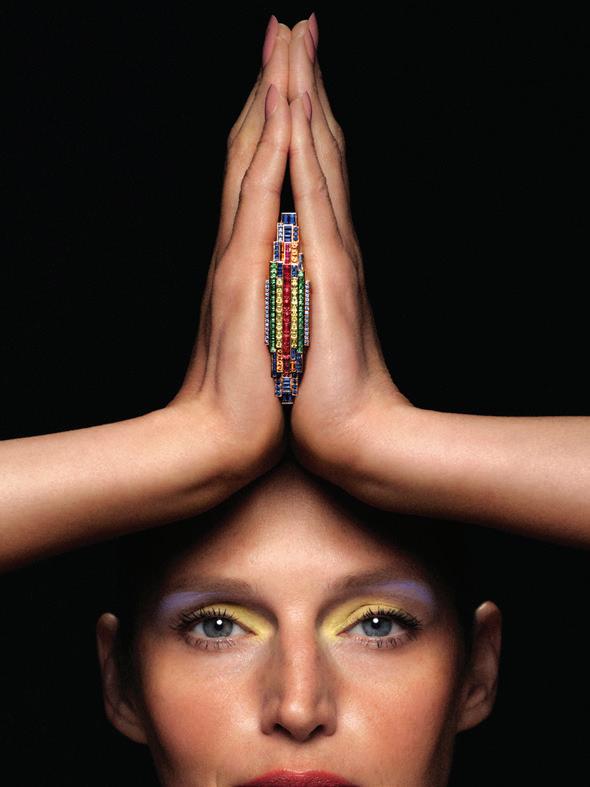
Thirty Jewellery
Pierre Hardy, Creative Director of Hermès Jewellery, outlines the inspirations behind his dazzling new high jewellery collection.
Editor-in-Chief & Co-owner
John Thatcher
john@hotmedia.me
COMMERCIAL
Managing Director & Co-owner
Victoria Thatcher
PRODUCTION
Digital Media Manager Muthu Kumar
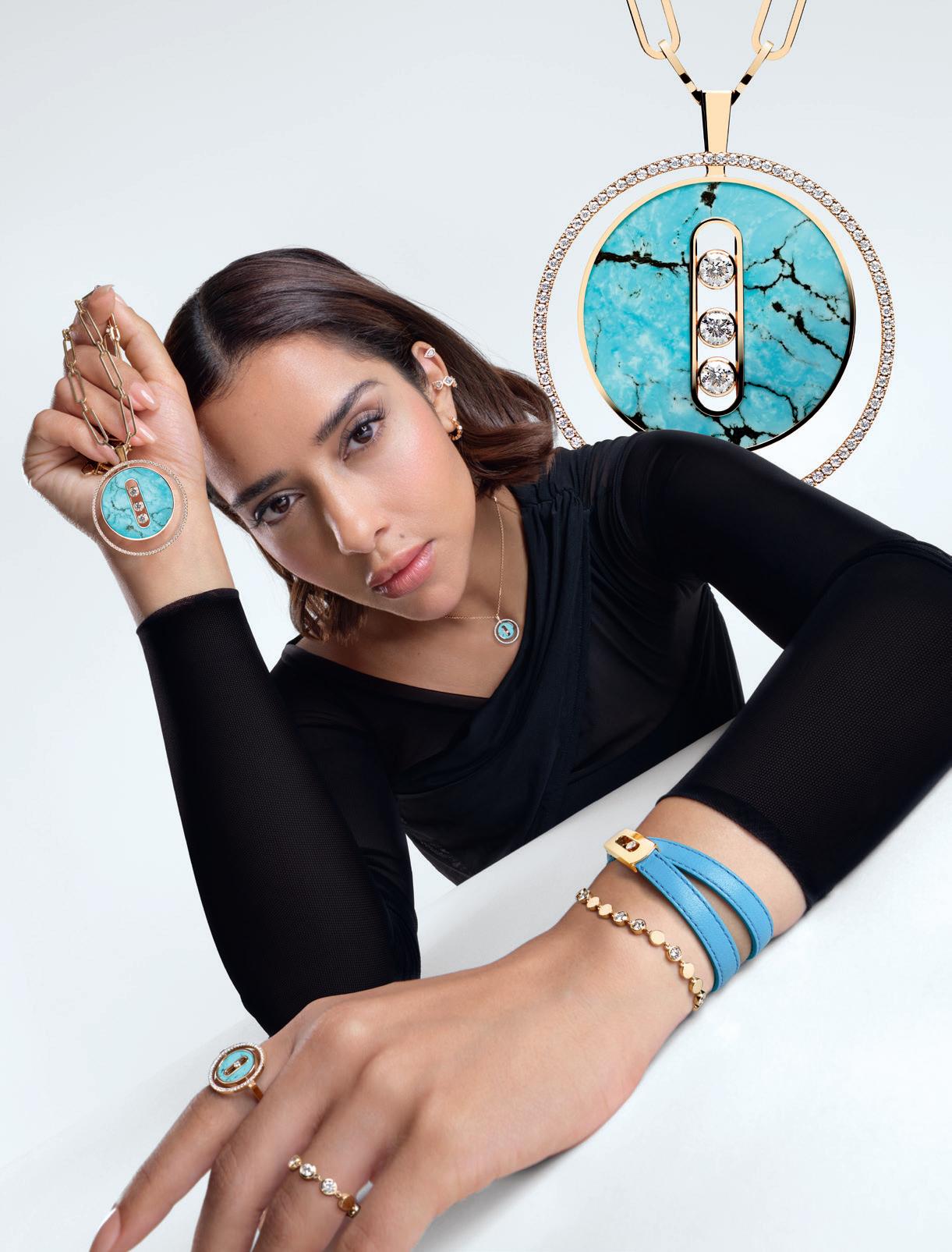

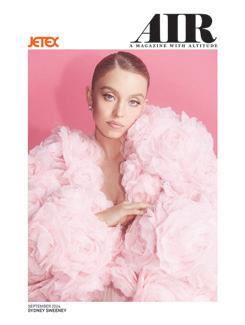
As we soar into the future of private aviation, we find ourselves at a pivotal moment where the possibilities are as vast as the skies we navigate.
At Jetex, our journey has always been defined by a relentless pursuit of excellence, a commitment to exceeding expectations, and a passion for innovation. Today, we are proud to share how Jetex is pushing the boundaries of what’s possible, ensuring that we continue to set the standard in the industry.
Innovation is the heartbeat of Jetex. It’s what drives us to constantly reimagine the private aviation experience. From the seamless integration of cutting-edge technology to the introduction of bespoke services tailored to the unique needs of our clientele, we are redefining what it means to travel in luxury. Our state-of-the-art terminals, advanced digital platforms, and pioneering sustainability initiatives are just a few examples of how we are transforming the industry and enhancing the experiences of those who fly with us.
But innovation at Jetex goes beyond technology; it’s about envisioning a future where private aviation is more personalized, more efficient, and more sustainable. We are exploring new horizons—whether that means expanding our global footprint, forging strategic partnerships, or investing in groundbreaking projects that will set new benchmarks for the industry. Our vision is clear: to be the most trusted, innovative, and customer-centric company in the world of private aviation.
As we continue to grow and evolve, one thing remains constant—our unwavering commitment to our customers. At Jetex, we understand that innovation is only meaningful if it enhances the experience of those we serve. That’s why we place our clients at the center of everything we do, ensuring that every journey is not only seamless but also unforgettable. Looking ahead, we are filled with excitement for what the future holds. The private aviation landscape is changing, and Jetex is leading the way. Together, we will continue to push boundaries, embrace new challenges, and create a world where the sky is no longer the limit.
As always, thank you for choosing Jetex for your global private jet travels. All of us look forward to taking you higher in utmost comfort and luxury –and with complete peace of mind.
Adel Mardini Founder & Chief Executive Officer


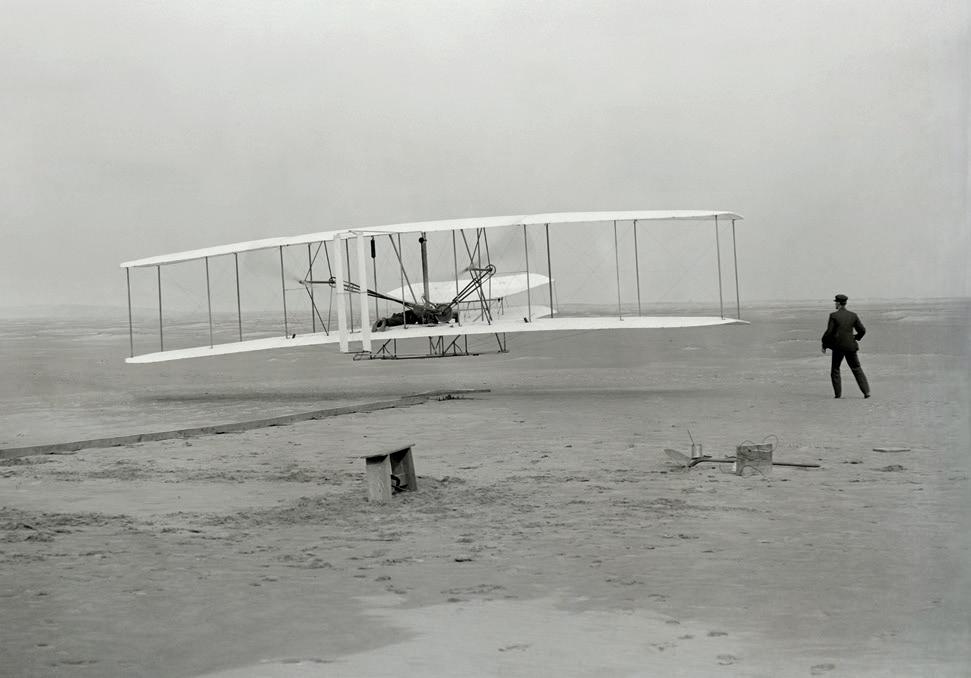
In the early 20th century, two unassuming bicycle mechanics from Dayton, Ohio, forever altered the course of aviation history. Orville and Wilbur Wright, better known as the Wright brothers, were the masterminds behind the first successful powered flight. Their relentless pursuit of innovation and their pioneering spirit laid the foundation for the modern aviation industry that we know today.
The Wright brothers’ journey into aviation began not with grand ambitions, but with a deep curiosity about the mechanics of flight. Inspired by the gliders of German aviation pioneer Otto Lilienthal, the Wright brothers were determined to solve the mysteries of controlled flight. Unlike many of their contemporaries who focused primarily on power, the Wrights recognised that control was the key to successful flight. This insight led them to design a three-axis control
system which allowed pilots to steer the aircraft effectively, maintain balance, and achieve sustained flight.
After years of rigorous experimentation and countless failures, the Wright brothers made history on 17 December 1903, at Kitty Hawk, North Carolina. Their aircraft, the Wright Flyer, soared for 12 seconds over the sandy dunes, covering a distance of 120 feet. Though brief, this flight marked the first time a manned, powered aircraft achieved controlled, sustained flight — a milestone that sparked a revolution in transportation.
The significance of the Wright brothers’ achievement cannot be overstated. Their work demonstrated that flight was not only possible, but could be achieved through a systematic approach to problem-solving. Their success was a testament to the power of perseverance, ingenuity, and a commitment to learning from failure. By combining their
understanding of aerodynamics with a practical knowledge of mechanics, the Wright brothers developed technologies and techniques that would become the cornerstone of modern aviation.
As the aviation industry evolved, the principles established by the Wright brothers continued to influence aircraft design and engineering. Their pioneering efforts opened the skies to exploration, enabling the rapid global connectivity that defines our world today. The Wright brothers did more than build an airplane; they launched an industry and in doing so, inspired generations of aviators and engineers to dream of new possibilities.
From that modest first flight at Kitty Hawk, the Wright brothers set humanity on a path that would lead to the jet age, space exploration, and beyond. Their legacy remains a testament to the power of innovation and the enduring human spirit.




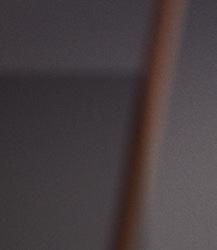

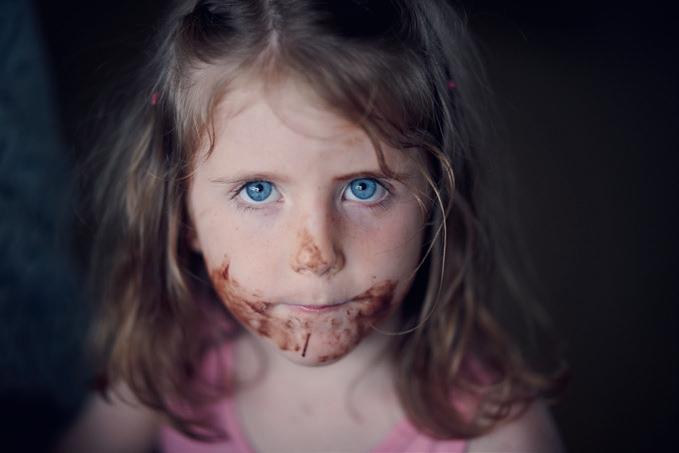


In an exclusive look at the process that brings its high jewellery pieces to life, in this case, a beautiful pair of Graphic Line earrings from its 80-piece Sport collection, Chanel reveals the process of first selecting the perfect precious stones to match the initital sketch – diamonds, sapphires, emeralds and onyx, chosen for their vivid, luminous intensity – then placing them in a handcrafted white gold and platinum setting. A pair of stunning sapphires, one of 4.77cts, the other 4.40cts, are the dazzling highlights.
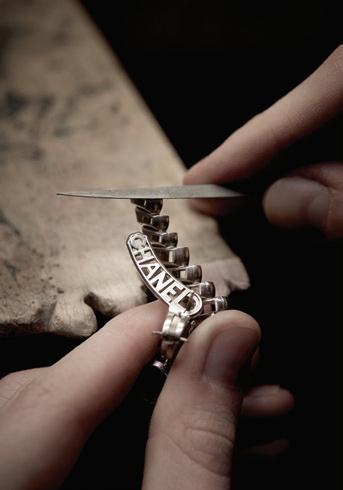
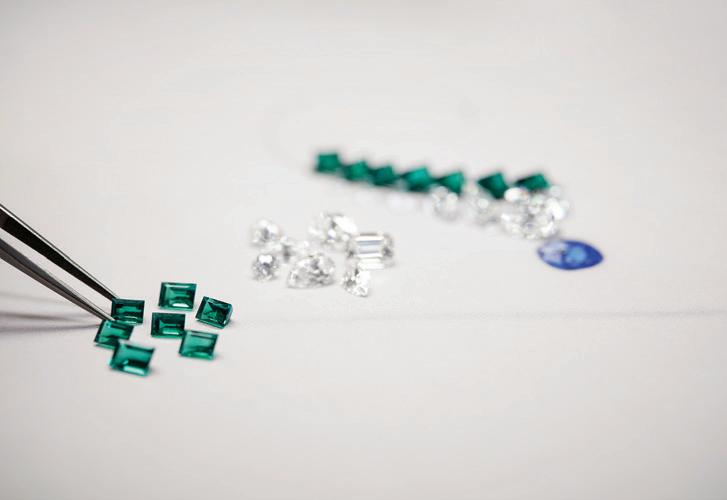
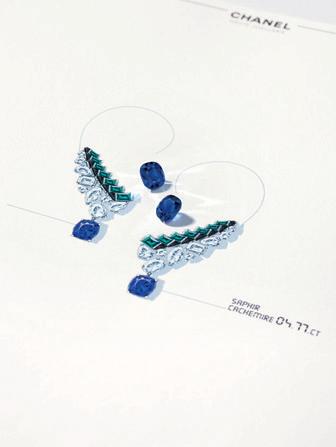
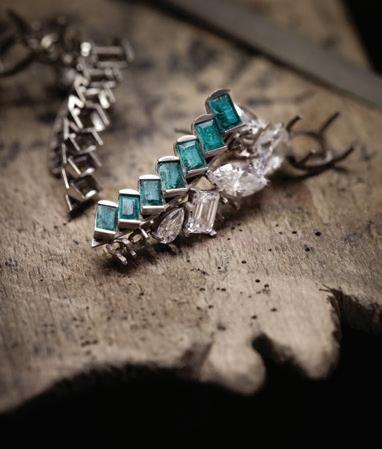
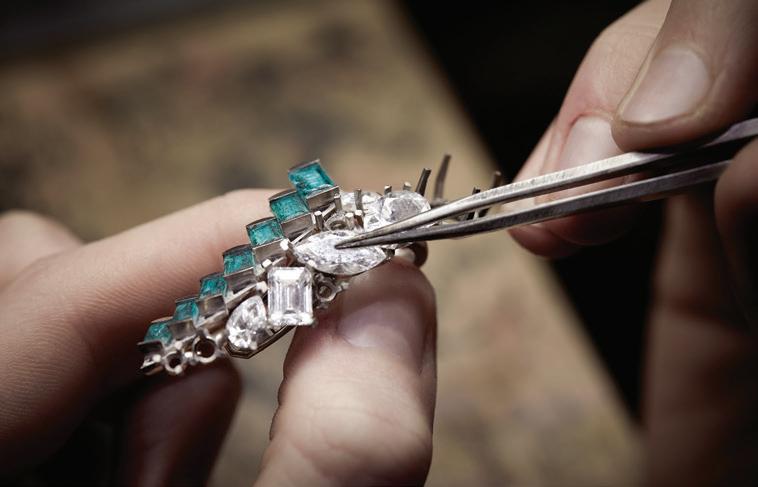
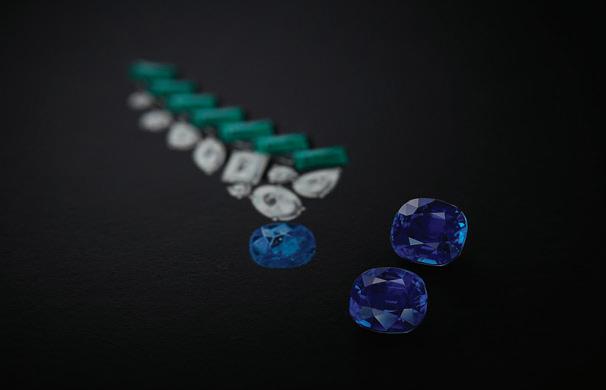

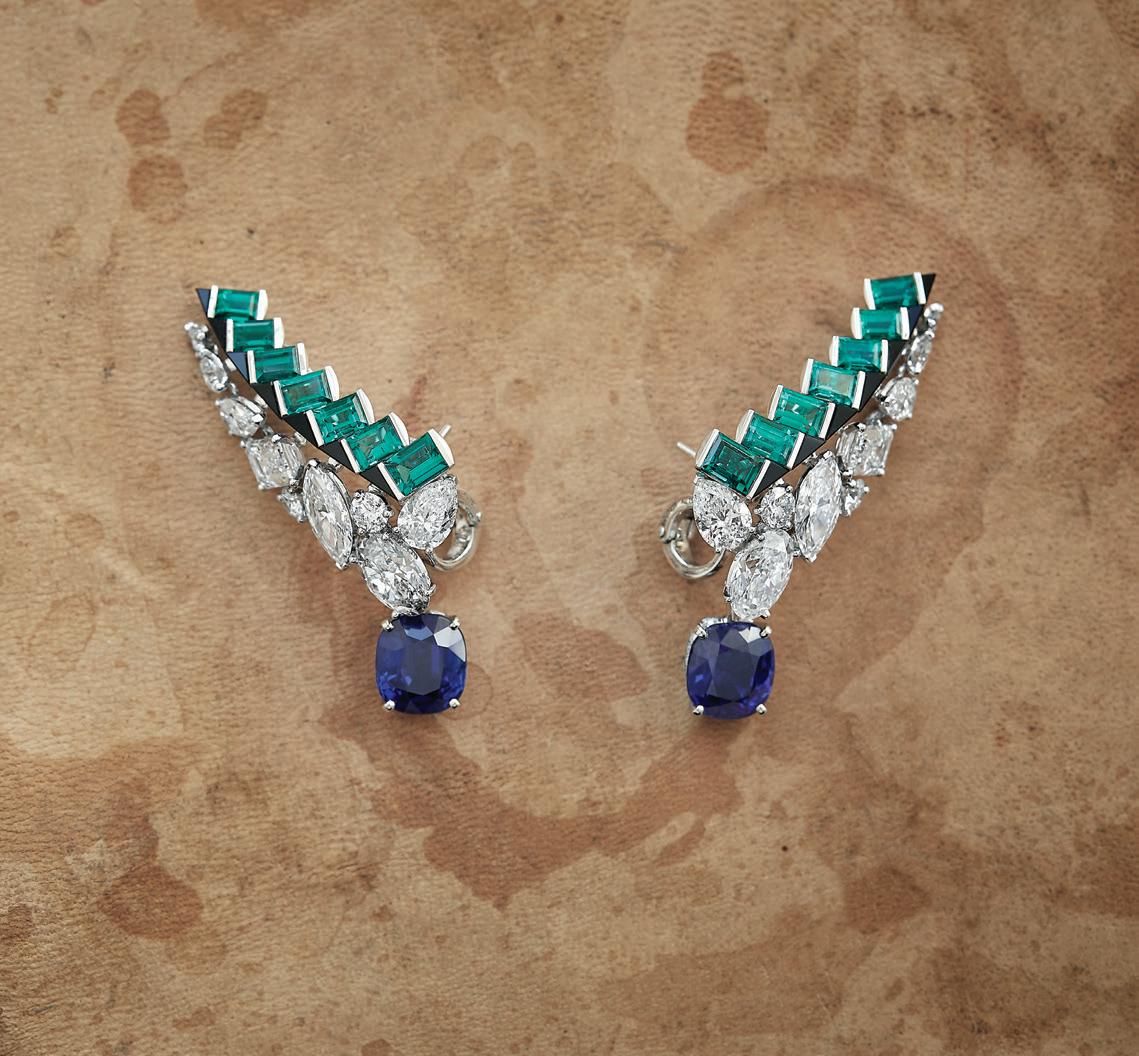
Master craftsmanship, effortless style and timeless appeal; this month’s must-haves and collectibles

“Since I was a young girl, I have had a passion for movies,” says Tissa Fontaneda. “Movies may transport us into different worlds, influence our senses, and sometimes make us fall in love with the characters – the way they act, smile, and dress.” The movie
she loves most of all is Cabaret , and it’s inspired her latest collection, as modelled by Anna Cleveland, which has been designed to reflect the contrasting personalities and styles of key characters from the film: Natalia Landauer and Sally Bowles.
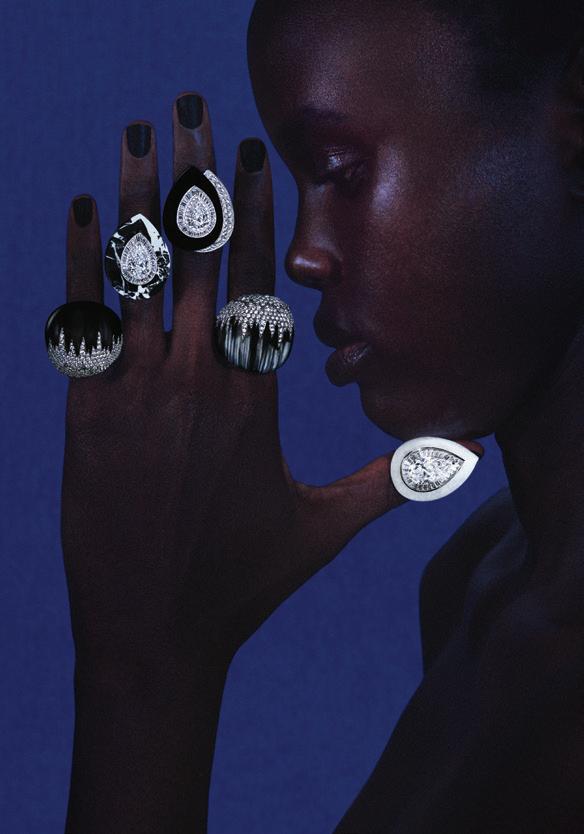
Boucheron’s Claire Choisne reveals two high jewellery collections each year. The first always draws inspiration from the Boucheron archive. The second grants Choisne free reign to imagine, challenging her team to push creative boundaries. Or Bleu is hailed as her
OBJECTS OF DESIRE 2
ode to memories of water, in particular those that flow through Iceland. The result is a collection of 26 pieces that evoke elements like the flow of a waterfall, the purity of a glacier, and the foam of the ocean as it breaks on the beach, as captured in these rings.
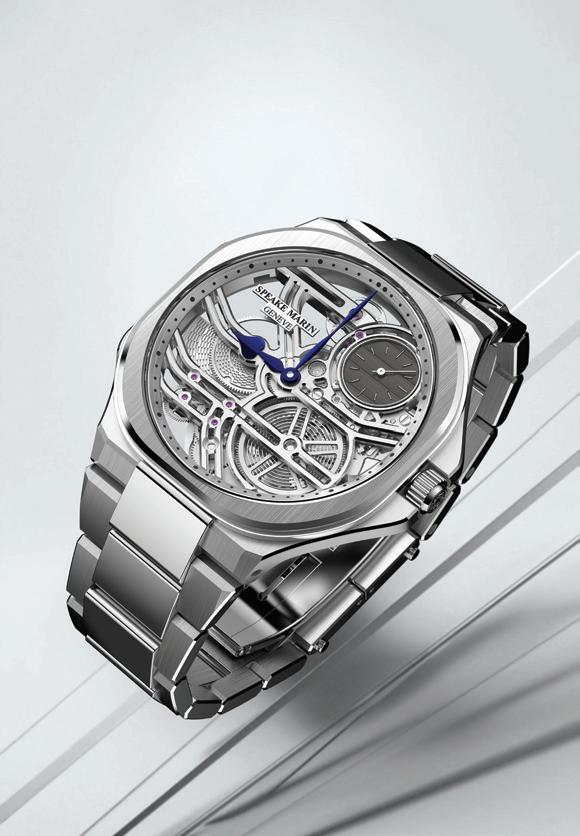
Speake Marin debuted its Ripples collection of sports timepieces in 2022, adding various versions but, until now, nothing as innovative as this: the line’s first skeleton dial and calibre. The in-house produced SMA07 movement – comprising 182 components and offering a 52-hour
power reserve – is only 3.25mm thick with a frequency of 5Hz, representing an industry first. Issued as part of a limited production, the Ripples Skeleton is housed in a stainless-steel case designed by Stéphane Lacroix that measures 6.30mm, a reduction of some 30% on previous models.

OBJECTS OF DESIRE
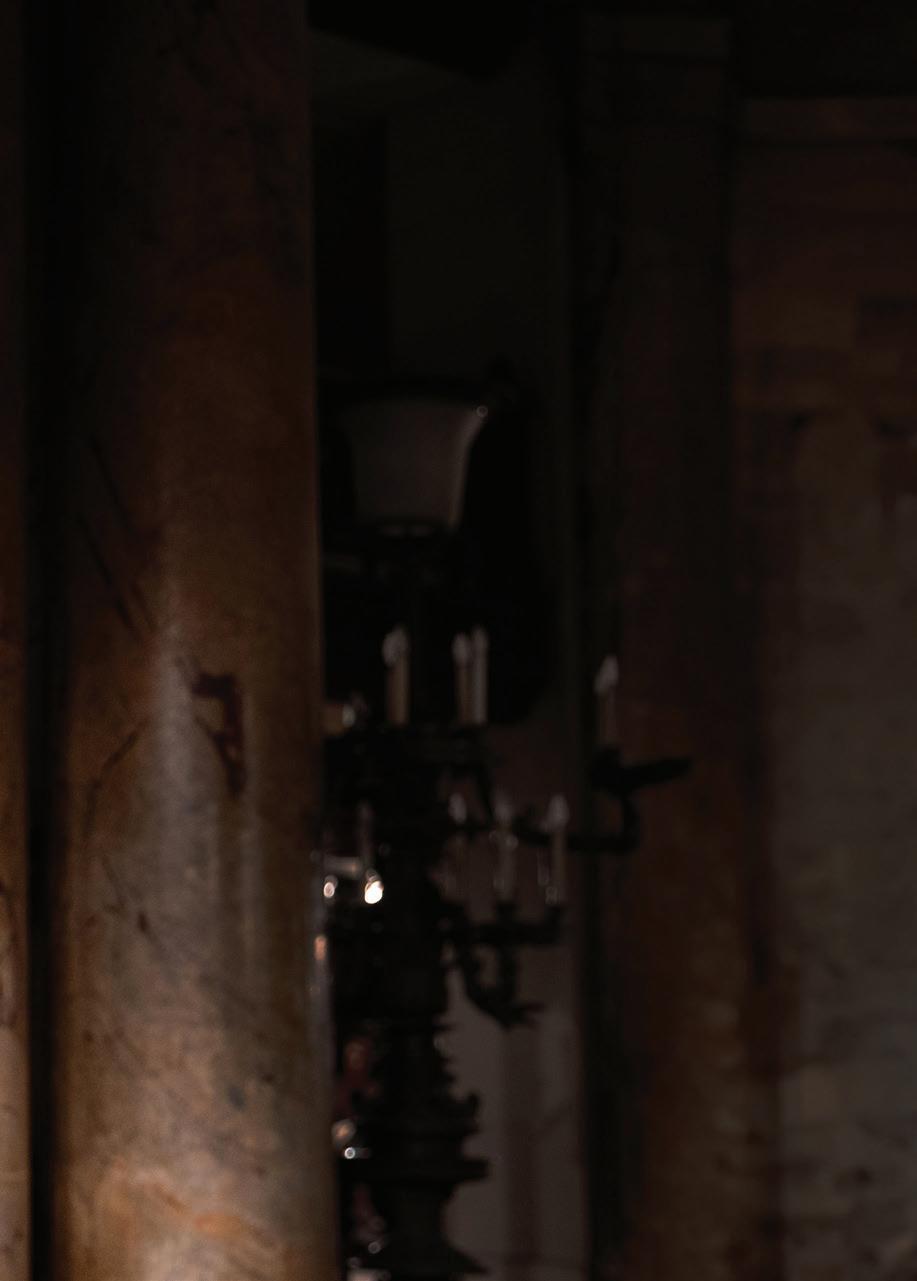
As we await news of who will assume the most coveted role in fashion as Chanel’s creative director, the label’s latest haute couture collection stayed true to the heritage of the house and the city of its founding. Close to Chanel’s ateliers at 31 rue Cambon
is the Palais Garnier, the historic opera house that has played its part in Chanel’s history and performs the role of muse here, making for a collection that’s big on opulent materials, rich embroidery and beautiful details.
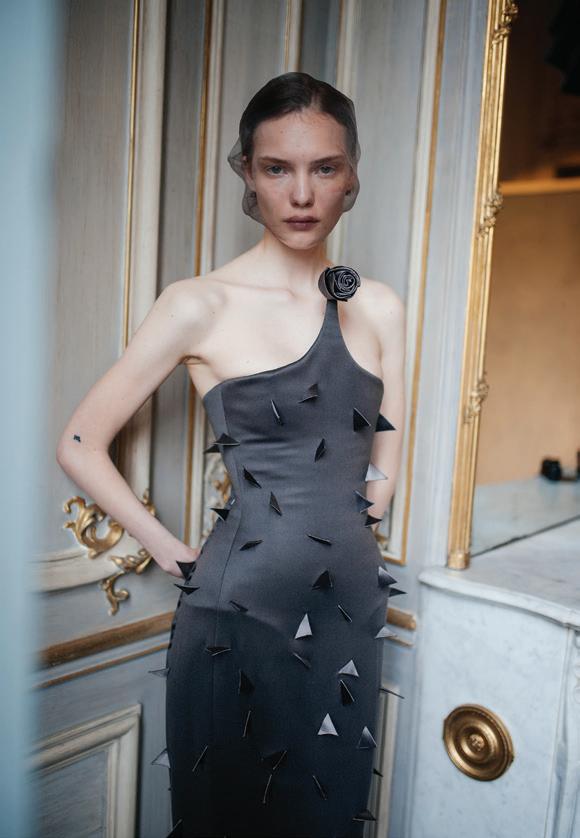
24-25
As is always the case with his everinventive haute couture collections, Daniel Rosebury finds endless inspiration in the label’s founder Elsa Schiaparelli, a woman who was branded an enigma for her carefree attitude when it came to conforming to convention. Salvador Dalí said of her, “No one knows how to say Schiaparelli, but everyone knows what it means.”
For this collection, Rosebury has chosen to reflect Elsa’s gift for rebirth, channelling it into pieces that are designed to elicit some type of emotion.
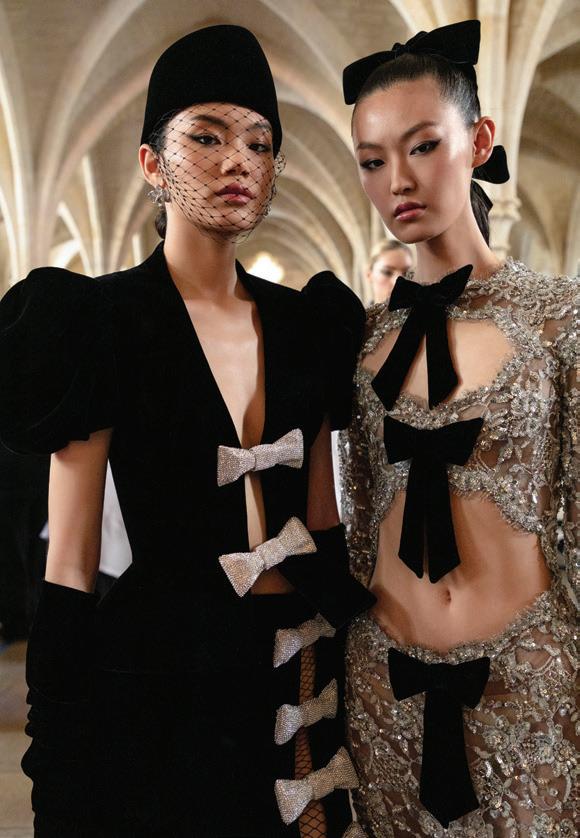
TAMARA RALPH
HAUTE COUTURE AUTUMN/WINTER 24-25
This summer’s Paris Haute Couture Week marked not only Tamara’s seventeenth season of couture but, more importantly, the first-year anniversary of her eponymous brand. She celebrated in style, showcasing a polished, creative collection rich in exquisite detail and masterful tailoring
under the theme of Lost in Love – perfect for the heart-stealing backdrop of Paris. Blossoming romance is symbolised in part by orchids, which embellish select pieces, while passion is expressed through colours like ruby red and mystery via luxurious fabrics with black crocodile effects.
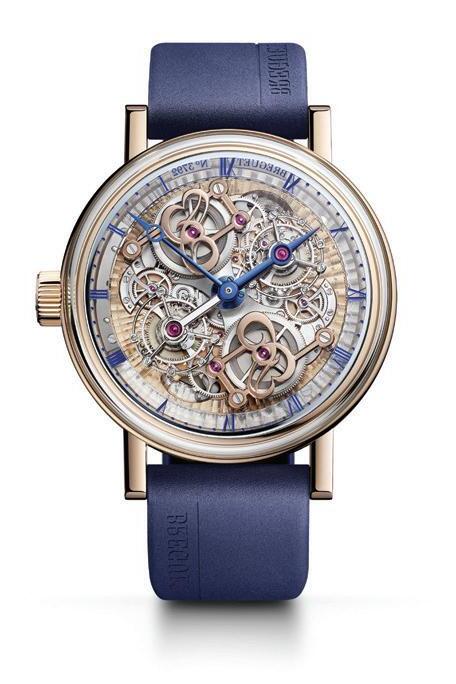
Created in tribute to its founder’s invention in 1801, Breguet’s new interpretation of the double tourbillon also celebrates the many artistic crafts the brand has since grown to excel at. They include guilloche, something of a Breguet signature, and its artisans
have created an entirely new pattern for this timepiece. It took more than 100 hours to create the engraving on the back of the movement. Done by hand, it depicts an aerial view of Abraham-Louis Breguet’s workshop at 39 Quai de l’Horloge.
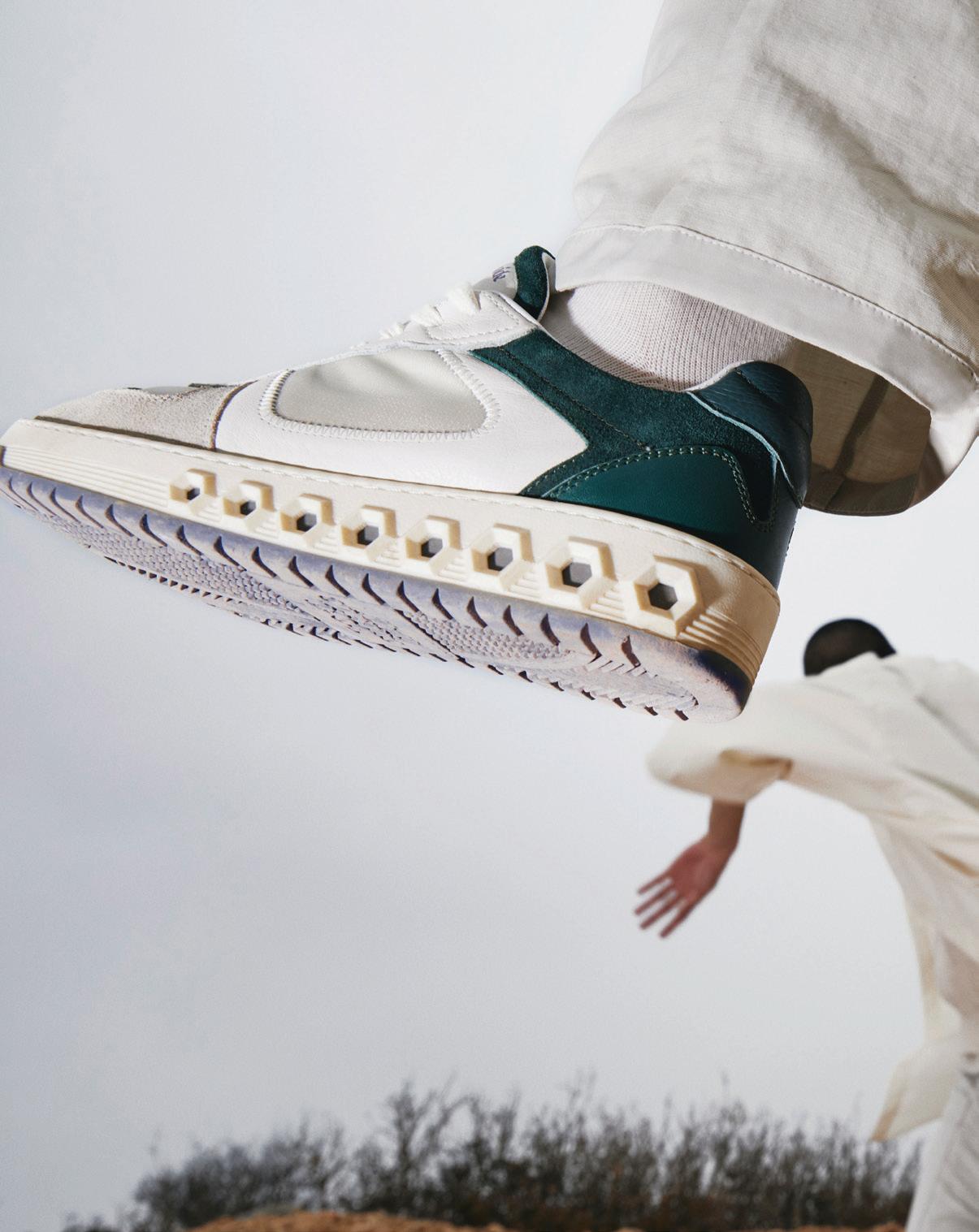
Founder Alfredo Bandini on how Born Outside Italy’s design ethos helped create an ultra-comfortable luxury sneaker

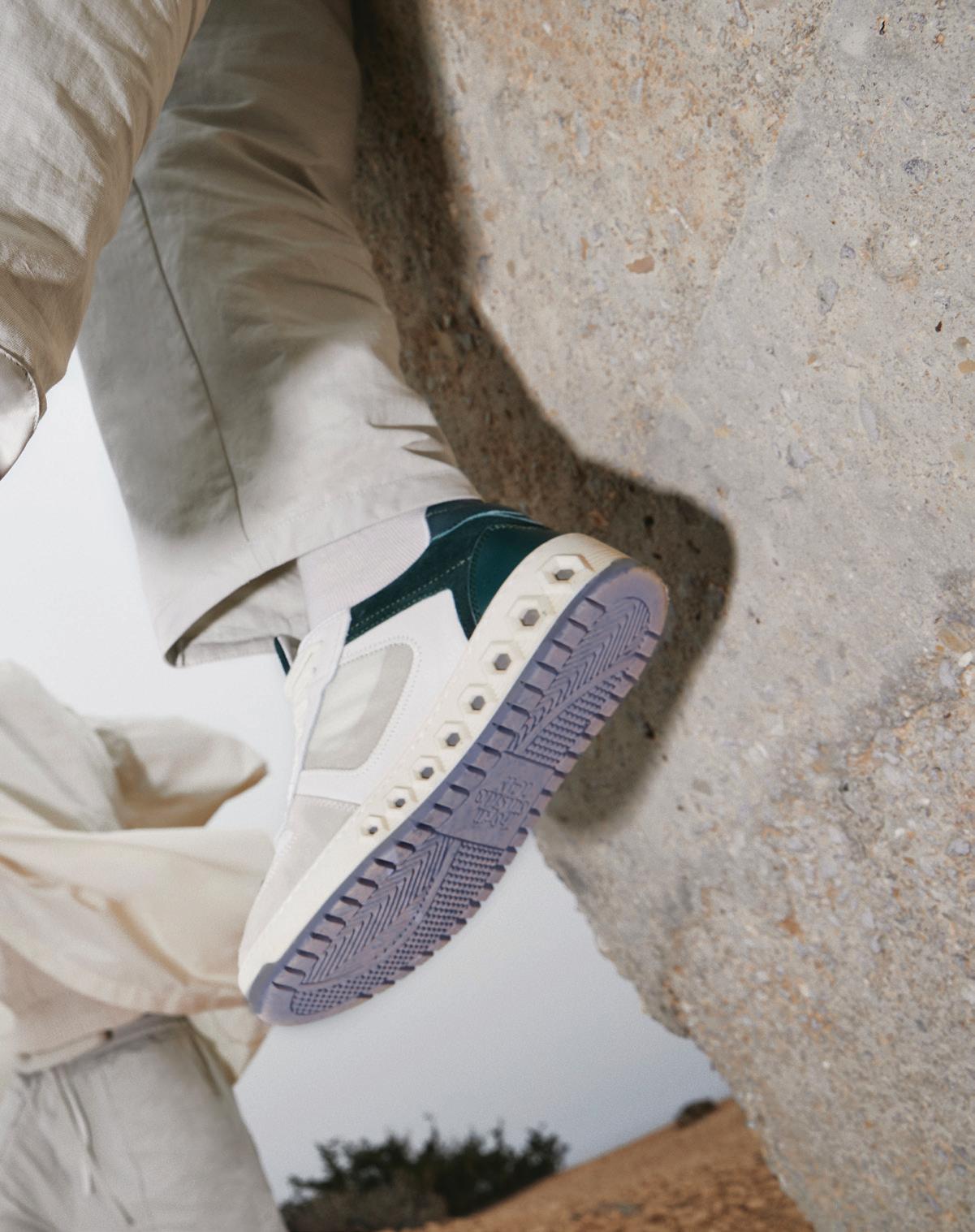

As is the case with all worthy entrepreneurs in the early stages of their first business venture, Alfredo Bandini is busy trying to juggle many things at once. He’s in Milan, driving back and forth across the city as he bids to strike deals, while also thinking about this evening’s call which will, if it goes well, see his fledgling brand stocked in one of the GCC’s biggest luxury department stores. He’s also speaking to me over Zoom while he’s at the wheel, and simultaneously testing out the comfort levels of the boxfresh sneakers he has on his feet. Released this month, they are the SNK002, the follow up to the SNK001, the first product released by Born Outside Italy, the UAEbased luxury fashion brand Alfredo has founded with business partner Daniele Pe.
The Italian-born duo, who share a love for fashion, design, and self-expression, founded their brand on the tenet that ‘luxury can be comfortable,’ creating a high-end product that takes the best of Italy – time-honoured craftsmanship and quality materials – and marries it to a spirit fostered in the UAE, hence the name. True to their word, what they have created is a luxury sneaker that is unquestionably the most comfortable I’ve ever worn, a conclusion I arrived at after spending the early part of the summer traipsing all over New York City, regularly topping 20,000 steps but never once feeling foot ache. Their comfort is due in part to their signature hexnut sole, a cushioned layer formed from thermoplastic rubber, a soft, flexible material that embraces the
shape of the wearer’s foot. “We wanted to create something that wasn’t attempted before and started off playing with holes and colours. Then we debated the shape and Janna introduced the idea of the six aspects of humanity,” outlines Alfredo. Janna is the third spoke in the wheel, the brand’s Creative Director, whose impressive CV includes collaborating with the hugely influential Virgil Abloh on Off-White sneakers. “First and foremost, she is very humble, and it’s hard to find such people in the world of luxury fashion.” says Alfredo, when outlining the reasons why Janna was the brand’s first hire. “I’m also inspired by Virgil [Abloh], so having the opportunity to bring onboard someone who worked with him was a real blessing.
‘ We knew that Italy was the one place in the world that truly understood how to craft a luxury shoe ’
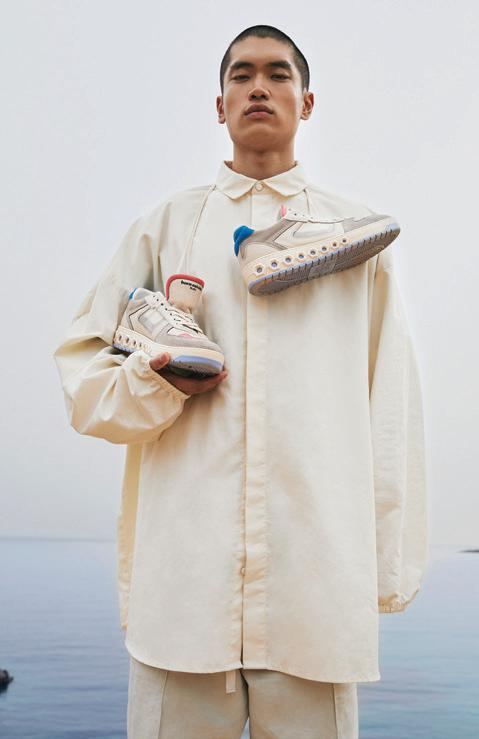
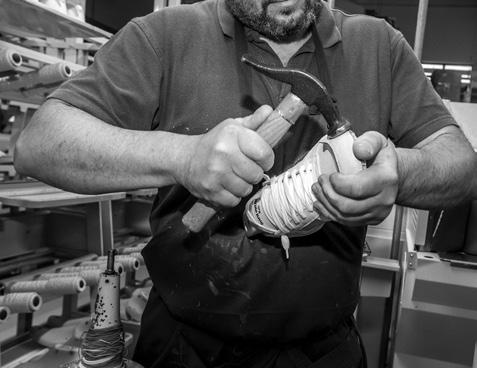


What she liked was our eagerness to disrupt, to create something new.”
For Alfredo, that ‘something new’ is a mix of influences. “Some things I wanted to take from the past, of how Italy used to do luxury. Others I wanted to take from the present, how certain brands behave today. The rest are a result of my values and beliefs.”
He talks of a deep respect for how Italian powerhouses Gucci and Ferragamo were born out of a love for simply making a great product first and foremost, nothing else, and how quality should be the cornerstone of a product, not the marketing of it. “In Italy we say that something is all smoke and no meat. My meat is the product. I need the smoke of marketing to be desirable, but it doesn’t come at the cost of the product.
“We knew that Italy was the one place in the world that truly understood how to craft a luxury shoe. The regions of Marche and Veneto, to be precise,” says Alfredo. “In Italy we fuse modern designs with production techniques passed down over generations. Only here do calzolaio (cobblers) work every day to produce beautiful shoes in small batches and in small factories.” All Born Outside Italy products are 100% made in Italy, using luxury Italian leathers and that centuries-old craft. As a byproduct, these are sneakers made to last. Such quality obviously comes at a cost, but Alfredo has ethics when it comes to pricing. “Our emphasis is on value for money. Over the last few years, I think brands have increased their prices too much and decreased their quality. I do think that in the long term there is space for a luxury brand at a much more reasonable price compared to others, and a product that you cherish for its quality, not for the name or marketing behind it.”
For the design of the SNK002, Alfredo talks of the concept of ‘street quiet’: ‘street’ being the brand’s more expressive design, ‘quiet’ its cleaner, more conservative sibling. “We want to take the liberty of playing sometimes in the middle, sometimes a bit more towards quiet, other times a bit more towards street. The SNK001 was in the middle, the SNK002 will be more quiet, then later this year we will release something that’s more street in style. With all three we can express the parameters of where our brand wants to play.”
Currently, the brand’s playground is limited to the GCC. “People here know how to judge a quality product and I do think there’s a big opportunity to create the story of a brand that starts from this region, rather than one adopted by it. Definitely the next two to three years are about doing well in the GCC, first with sneakers, then with ready-to-wear in early 2025.”
Then comes the world, one very comfortable step at a time.



the

We’ve all had them. Those big nights out that take us through to sunrise on a wave of unbridled joy. For most of us, the upshot is a headache next morning. For Valérie Messika, the result is a spectacular high jewellery collection. “I have so many magical memories of parties that lasted until the end of the night, when we leave the dance floor to meet the first rays of the sun,” says Valérie. “The excitement of the night persists in the light of dawn. It's a unique moment, like suspended time between yesterday and today.” It sparked the idea for 2023’s Midnight Sun collection, the first opus of which featured a masterpiece necklace set with a stunning 20.04-carat pearcut yellow diamond, and continues into this year with the release of its equally beguiling second opus.
“The first opus captured the essence of the party scene, featuring iconic venues like Studio 54 and Chez Régine,” says Valérie. “This second opus continues the story, drawing inspiration from the transitional moments that follow the end of the party, where all the colours seem to change.”
Taking its creative cues from this twilight zone, where the final glimmer of the stars meets the first burst of sunlight, Midnight Sun Opus II emphasises the contrast between light and dark. And, as always with Messika, it’s a collection laced with daring technique. “Our unique innovation this year takes the form of real sparkling diamond bubbles seen through the unique snow setting technique we used for the White Midnight Sun set,” outlines Valérie. “This set reveals a perfect mastery of the work of light and volume. Its semi-rigid collar with exceptional volume presents remarkable link work. All the elements of this magnificently rounded curve come together in a perfect trompe l’oeil, enhanced by the snow setting. A daring feat, this exceptional setting required nearly 300 hours of work in the maison’s workshops.”
Overcoming technical challenges is commonplace at Messika, reflecting Valérie’s continued desire to break new ground. “One of the biggest technical challenges we faced for the second opus collection was mastering the interplay of light and contrasts to reveal pieces that are both enigmatic and bright. Creating

‘One of the biggest technical challenges we faced was mastering the interplay of light and contrasts’
real sparkling diamond bubbles within an exceptional snow setting required precision in setting the diamonds to ensure they maintained their brilliance and sparkle while achieving the desired ethereal, snow-like effect.” But her favourite piece is the striking So Move Max necklace. “I love this creation so much as it combines allure and exceptional know-how. It resembles me and perfectly reflects the image of the maison. It’s bold and powerful.”
To paraphrase the famous show tune, diamonds are Valérie’s best friend. “I have had a special relationship with diamonds since I was a little girl. They have always been able to ignite the playful side in me. I love looking into their purity, especially when I run them between my fingers and watch them shine and sparkle under the light. I look to reveal as much of the diamond as possible in every creation by decreasing the amount of gold surroundings, making them look like a tattoo, a second skin, something that is very comfortable to wear. It is an intuitive instinct that I have, which helps me choose the right diamond that screams ‘Messika.’ The details, proportions, and versatility of the diamond allow me to play with each piece, changing the way it’s positioned on the creation, the overall design, and the way it is used to bring something very special to life each time.”
To front Messika’s latest advertising campaign, Valérie turned once more to catwalk royalty; Natalia Vodianova
Opening pages, from left to right: White Midnight Sun necklace ©Pierre Vérez; Natalia Vodianova wears Lunar Diva clip, pendant earrings, necklace and ring ©Vito Fernicola
This page: White Midnight Sun ring ©Pierre Vérez Opposite page, clockwise from right: Lucien Laviscount wears Groove set ©Vito Fernicola; So Move Max necklace ©Pierre Vérez; Natalia Vodianova wears Diamond Frequencies clip, pendants, choker and necklace ©Vito Fernicola; Lunar Diva necklace ©Pierre Vérez
taking over duties from Carla Bruni.
“Natalia and I share a long-standing friendship. We met a few years ago and have worked together several times since. She is a multi-faceted woman: a supermodel, a mother, and a committed woman of action.”
Vodianova is one such woman in Valérie’s life, and she’s swift to hail the role of others. “I wouldn’t be where I am today without the support of the incredible women around me. I have always been aware that I am very privileged to be able to experience the journey I am on right now, and I’ve been wanting for a long time to pay it forward. To do something for underprivileged women and children around the world who would benefit from any help they received – no matter how small.”
Since 2021, the Valérie Messika Foundation has been doing just that, supporting organisations in favour of women and children in the fields of education, culture and health.
Throughout 2022 and 2023, more than 4,000 hygiene kits were distributed to the most deprived young women internationally, while a Messika Cares collection of jewellery pieces was launched to donate a percentage of its profits to NGOs, so far helping the needy in places like Lebanon and India.
It's all part of Valerie’s vision which, with her eponymous brand set to celebrate its 20th anniversary next year, continues to evolve. “My journey in the jewellery industry has always been about breaking stereotypes and redefining luxury for the new generation. To break codes and empower every modern woman to be herself without restrictions. If I looked up too far, I would have been afraid to climb, so I just followed my intuition throughout the years and continued walking down the path I was on.”
Wherever the path leads next, the future for Valérie Messika is as bright as her diamonds.


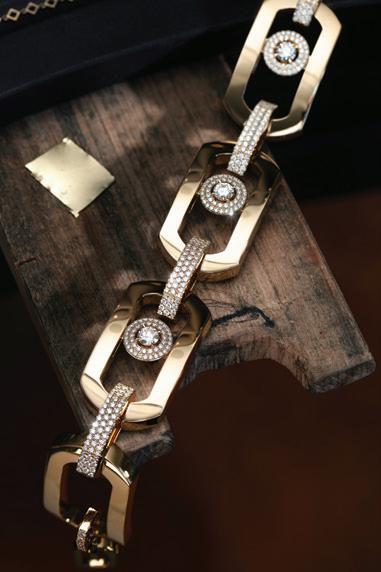
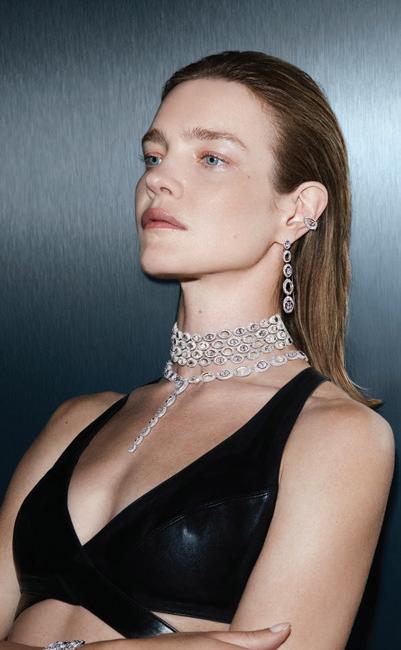

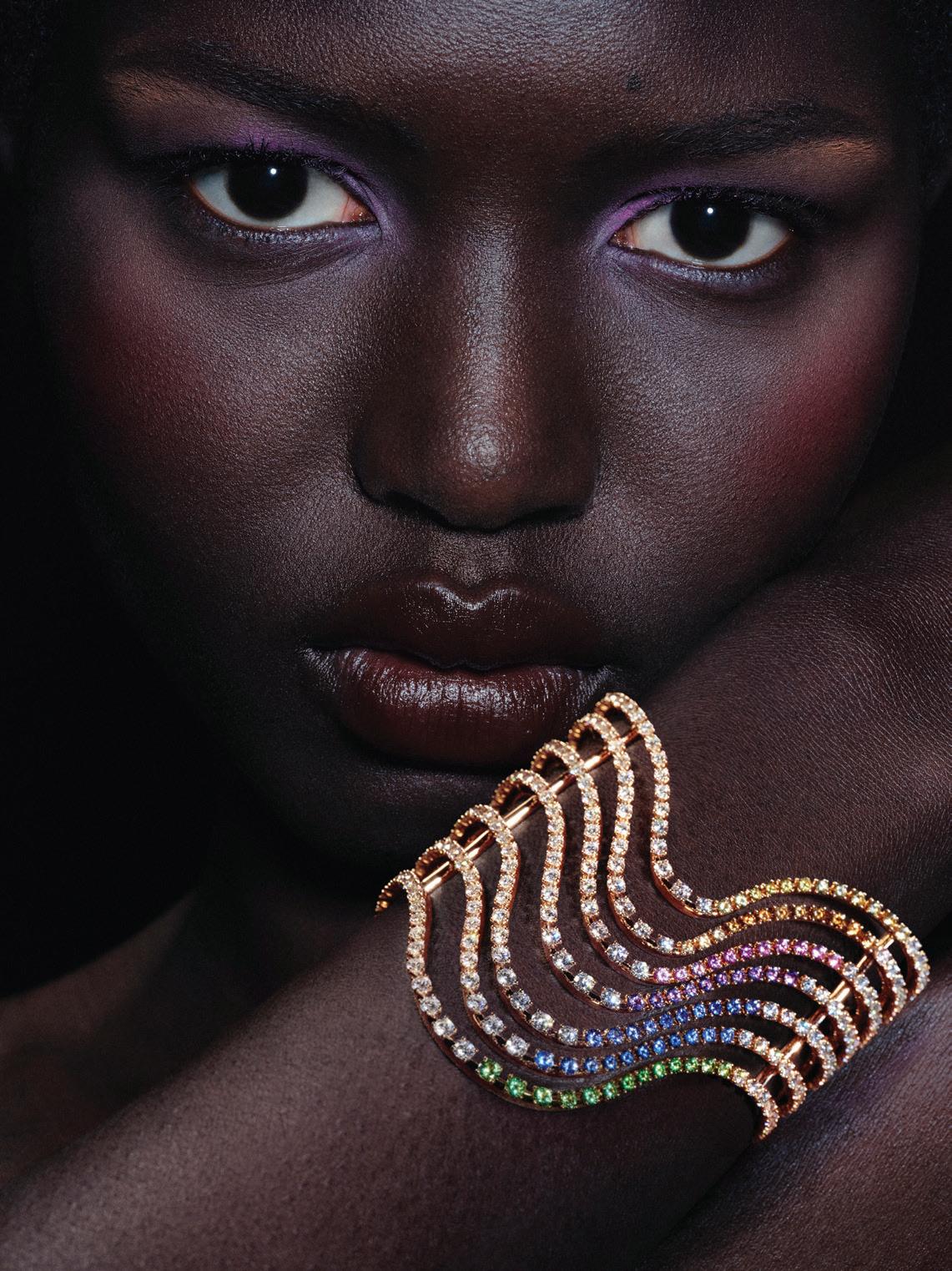

Sometimes the theme of a high jewellery collection can be so nuanced that it’s hard to decipher. Other times it’s strikingly obvious. Hermès' latest high jewellery collection can certainly be characterised among the latter, and the visual impact is instantly dazzling. “This collection expresses colour in shapes,” outlines Pierre Hardy, Creative Director of Hermès Jewellery. “I wanted to find a way to express this fundamental phenomenon – of colour, at Hermès – and build a strong, autonomous and independent identity.’
Expressed across multiple chapters, Les Forms De La Couleur is a study of colour and form, of magnificent stones and exceptional creativity.
“This collection asserts the goal of inventing a vocabulary that moves away from the house’s recognisable shapes. A vocabulary of emancipation
that embraces a certain sense of freedom, and involves jumping over obstacles, to use an equestrian image.”
Such obstacles include the technical prowess required to produce the intricate mesh work that’s a feature of the bracelets and necklaces in Arc en Couleurs, which follow the contours of the body and for which 1,400 stones were painstakingly selected to create a beautiful colour gradient on what is a stunning necklace. For Supracolour, the challenge was to demonstrate the diffraction of light waves; the passage from black and white through a triangle-cut diamond and their emergence as rays of colour. In Fresh Paint, the notion of movement is evoked along with the illusion of painting through a mixture of savoir-faire and carefully selected stones. While for the one-off necklace in the Hermès
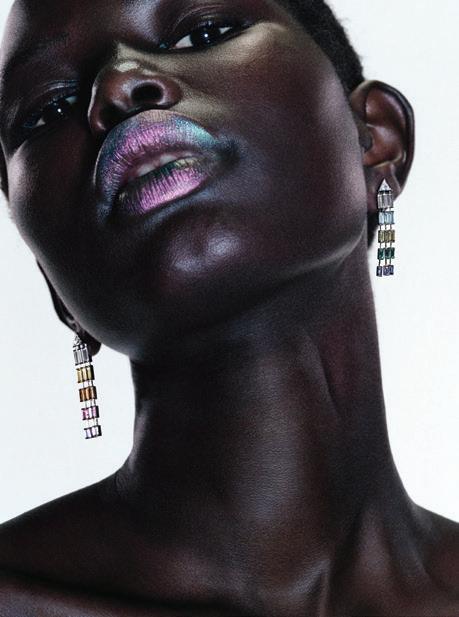
‘ Colour is a natural resource on which we can draw infinitely, and I wanted to explore the whole spectrum’
Diaprés chapter, each mother-of-pearl insert was individually cut to fit.
“Colour is a natural resource on which we can draw infinitely, and I wanted to explore the whole spectrum,” enthuses Hardy. “In addition to precious stones, we have also used semi-precious stones to give us a broader, more precise palette. High-quality jewelling and stone-setting then produced subtle colour gradients. The work of the jeweller is an almost supernatural, magical transformation from one substance to another that involves organising a series of shifts from one universe to another: from sketches on paper to objects in stone and metal, from the theoretical to the ornamental, from a two-dimensional representation to a three-dimensional piece.”
Having such skilled jewellers at hand gives Hardy the freedom to
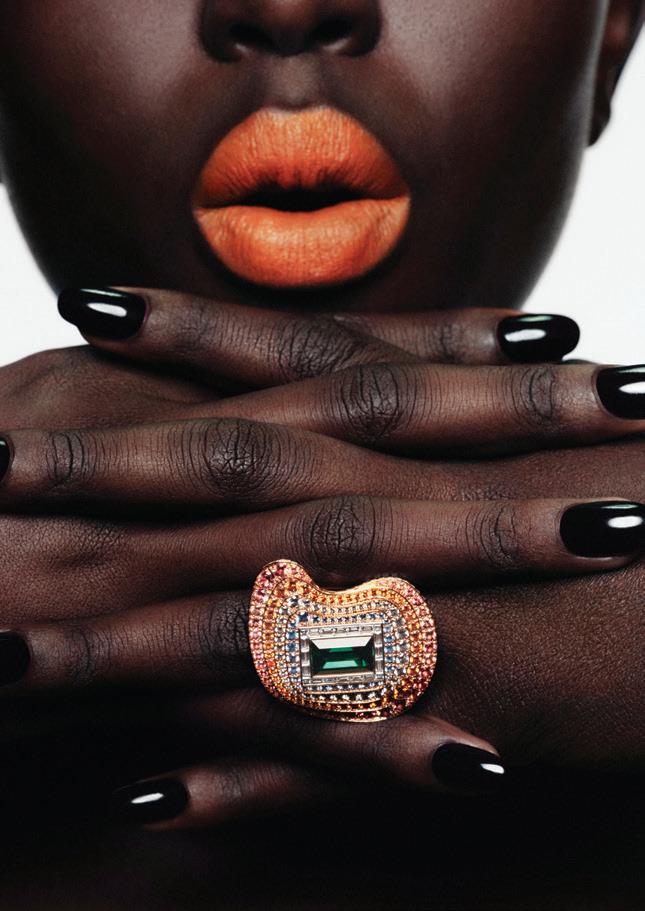
create without restrictions. I wanted to express a lot of ideas at the same time. It’s possible to want some quite different things all at once. However, I wasn’t trying to use colour to unite a range of heterogeneous objects. Quite the opposite, in fact. The exploration of colour has produced extremely rich and extraordinarily diverse results. Rather than stifling this diversity I wanted to pay tribute to it and give it every opportunity to resonate and flourish. I have not sought to restrict, but rather to allow.”
This idea is evidenced elsewhere in the collection, most notably in the eyegrabbing geometric pieces in Colour Flash, which bring to mind the digital world, and some of the intriguing shapes crafted for Colour Vibes, a marriage of the traditional and the contemporary through the use of classically cut
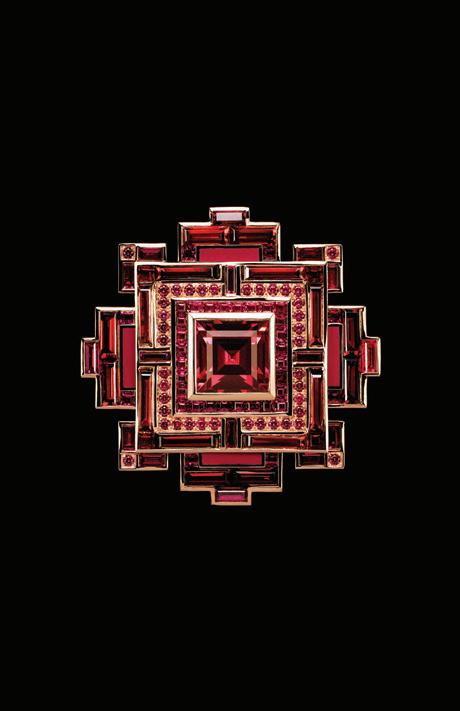
precious stones. This is where Hermès’ rich history comes into play. “The house can create a whole variety of symbols, revisit its original shapes. and open up other avenues,” explains Hardy. “It’s precisely this eclecticism that defines the identity of the collection, in which the aim has been to consider the way in which colour is applied to the body, a little like make-up, to explore the images of colour ingrained in my mind, or to focus on the history of jewellery. I wanted to combine all this, to make it contemporary and ‘Hermès’ by seeking out as much of the wonder generated by colour as possible – the kind of wonder tinged with astonishment we might feel, for example, when a black and white film is colourised.”
To achieve this goal, this is the first time in the house’s history that such a wide variety of stones
has been used in high jewellery. Hardy’s fascination with colour can be traced to his art degree, when he learned about the theories of colour.
“Some pieces are based on these theories and lead to more narrative explorations. I like to start with something that is quite strict, defined and rigorous in structure, and then organise the diffraction from it,” explains Hardy. “The combination of a colour and a shape sets the mind thinking: if red is square, what is that square saying? If yellow is triangular, the mind could fleetingly visualise the symbol on a superhero’s outfit, for example, or it could be linked to other memories, such as a work of art, an album cover, a piece of architecture, or a feeling.”
The overriding feeling from Hardy’s colourful creations is very much joy.
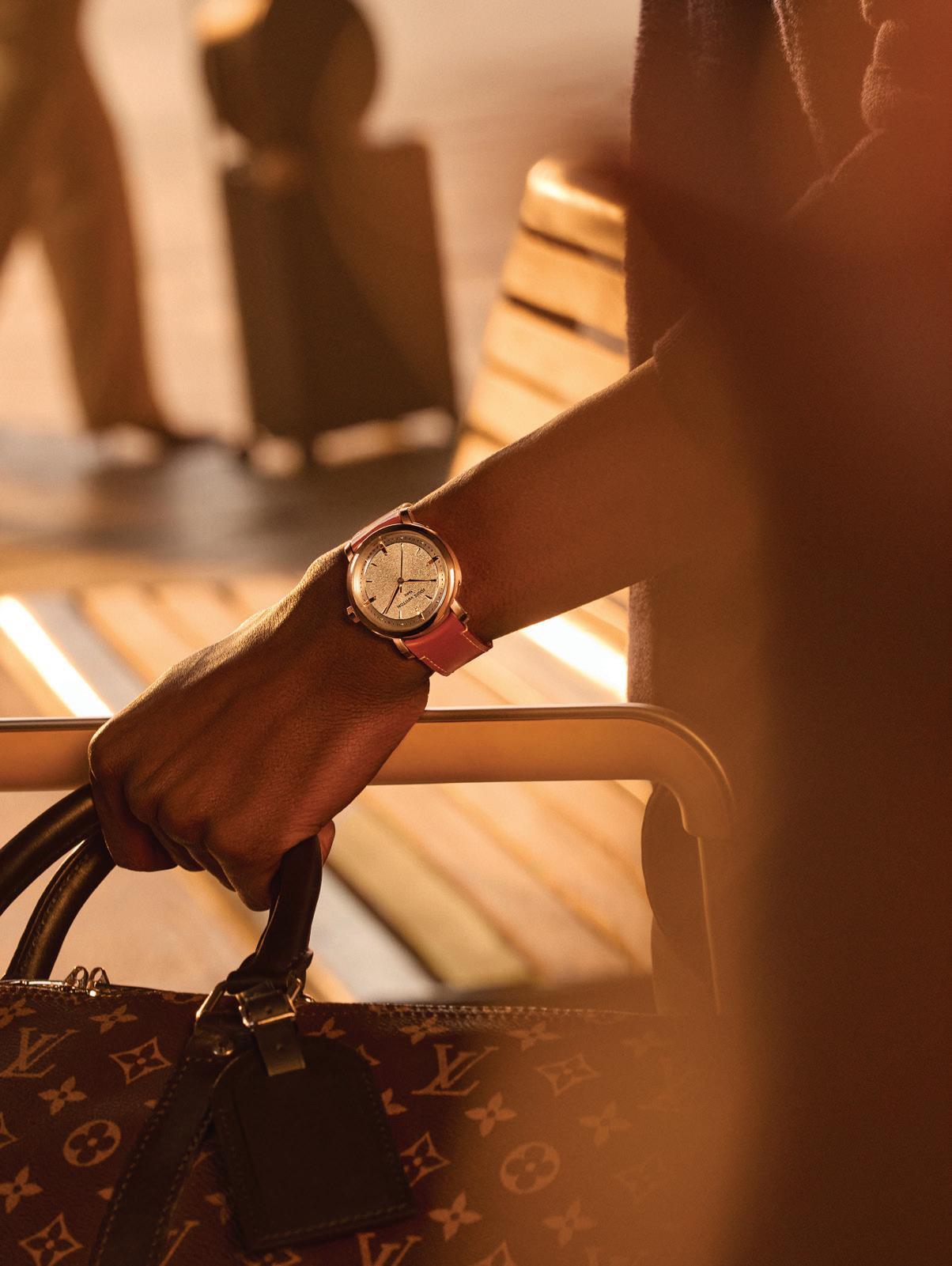
Highly textured and tactile surfaces are features of Louis Vuitton’s new trunk-inspired Escale models
WORDS: JOHN THATCHER
Since acquiring La Fabrique du Temps manufacture in 2011, Louis Vuitton has been on a journey, a quest for excellence and a seat at the top table of serious watchmaking. They couldn’t have started in a better place. La Fabrique du Temps was founded in 2007 by master watchmakers Michel Navas and Enrico Barbasini, whose industry experience is second to none, including seven years under the tutelage of Gérald Genta, the legendary designer behind the likes of the Audemars Piguet Royal Oak, Patek Philippe Nautilus, and IWC Ingenieur. It didn’t take long for the duo to make their mark under their new banner of La Fabrique du Temps
Louis Vuitton, developing Vuitton’s first minute repeater within months of
the acquisition and following up with further innovations. They also convinced Vuitton to revive the Genta brand, along with its distinctive Disney timepieces.
Earlier this year saw the release of The Escale Cabinet of Wonders, a magnificent trio of métiers d’art timepieces inspired by the personal collection of Gaston-Louis Vuitton, the grandson of Louis Vuitton. It marked the first Escale since 2014’s Worldtime, distinctive for its colourful dial, which employed the use of miniature painting techniques and a pioneering worldtime function. Ten years on and four new models have been released that define the new Escale, a dressier companion to last year’s sporty Tambour. Classic in nature, two are in rose gold, the

other two in platinum, while all four feature a case reworked from the original, textured dials, leather straps, and highly skilled hand finishes.
Each piece also owes its design heritage to Louis Vuitton’s iconic trunkmaking. As with previous Escale models, the lugs are crafted to resemble the brass brackets and corners that reinforce Louis Vuitton trunks, while the crown is octagonal and domed to mimic the shape of a trunk’s rivet. The link is further reinforced on the dial, where angled and riveted markers in polished gold are placed at each quarter. Not simply decorative, the markers have been applied by hand to hold together the centre dial and the outer minute track, which is also punctuated with gold studs in a nod to the nails that


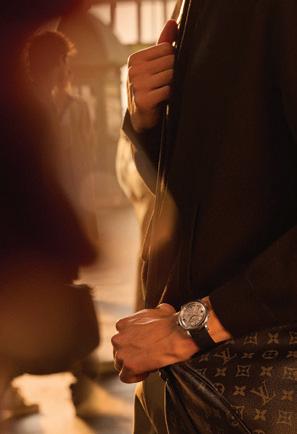



‘The platinum versions up the ante when it comes to materials and techniques ’
run along the trunk’s exterior.
The rose gold models have either silver or blue dials, each one given texture by a process of stamping. The final result – perfected after much experimentation with materials –echoes perfectly the grained surface of the brand’s Monogram canvas, a fine accomplishment on a metal dial.
It’s Louis Vuitton’s leather goods domain that the Escale’s beautifully crafted hands celebrate, shaped like the finely tapered needles used by the artisans in the maison’s hallowed workshops. Then there’s the yellowstitched strap on the silver dial rose gold version. It draws inspiration from Nomade, a natural leather originally introduced in 1999 that, over time and through use, will gradually lighten in colour, just like some of the brand’s most coveted leather products.
The platinum versions up the ante when it comes to materials and
techniques. One features a meteorite dial, chosen to highlight the contrasting textures and natural mineral tones of this otherworldly material. The other dial is onyx, the depth of its darkness accentuated by the contrasting sparkle emanating from a bezel and case that’s set with baguette-cut diamonds. And whereas the rose gold models have matching rose gold hands, the hour and minute hands on the platinum models are white gold, with a titanium seconds hand selected because it’s lighter and more energy efficient than gold — so that it exactly matches the colour of the white gold hands, it’s treated with a PVD colour process. Such is the level of perfection. Making it energy efficient is an important factor to maintain the 50hour power reserve that comes courtesy of the LFT023, the first proprietary automatic three-hand movement designed by La Fabrique du Temps Louis
Vuitton in conjunction with movement specialists Le Cercle des Horlogers. It debuted in last year’s Tambour models and boasts its own design references to the maison — the mainspring barrel and 22ct rose-gold micro-rotor both decorated with Vuitton motifs. The trunk is, of course, emblematic of the house, the catalyst for the young Louis Vuitton to begin his leather goods company and from which all its success has stemmed. So it’s a nice touch that the final nod to it in this Escale timepiece comes via the engraved serial number in contrasting gold that’s riveted to the periphery of the transparent caseback, similar to the engraved serial number plates that identify each Louis Vuitton trunk. This engraving has been purposefully placed on the watch to rest directly on the wrist, providing a sensory link between the wearer and the history of Louis Vuitton. A shared moment in time, perfectly crafted.

A masterful marriage of tradition, modernity, innovation and refinement — inside and out — the expertly designed Range Rover is the definitive luxury SUV. Relentlessly comfortable and a joy to drive, it’s also the ultimate travel companion, transporting you in sophisticated style with its peerless performance to wherever the road may take you
CAR: RANGE ROVER HSE P530
PHOTOGRAPHER: ŽIGA MIHELČIČ
LOCATION: ONE&ONLY THE PALM

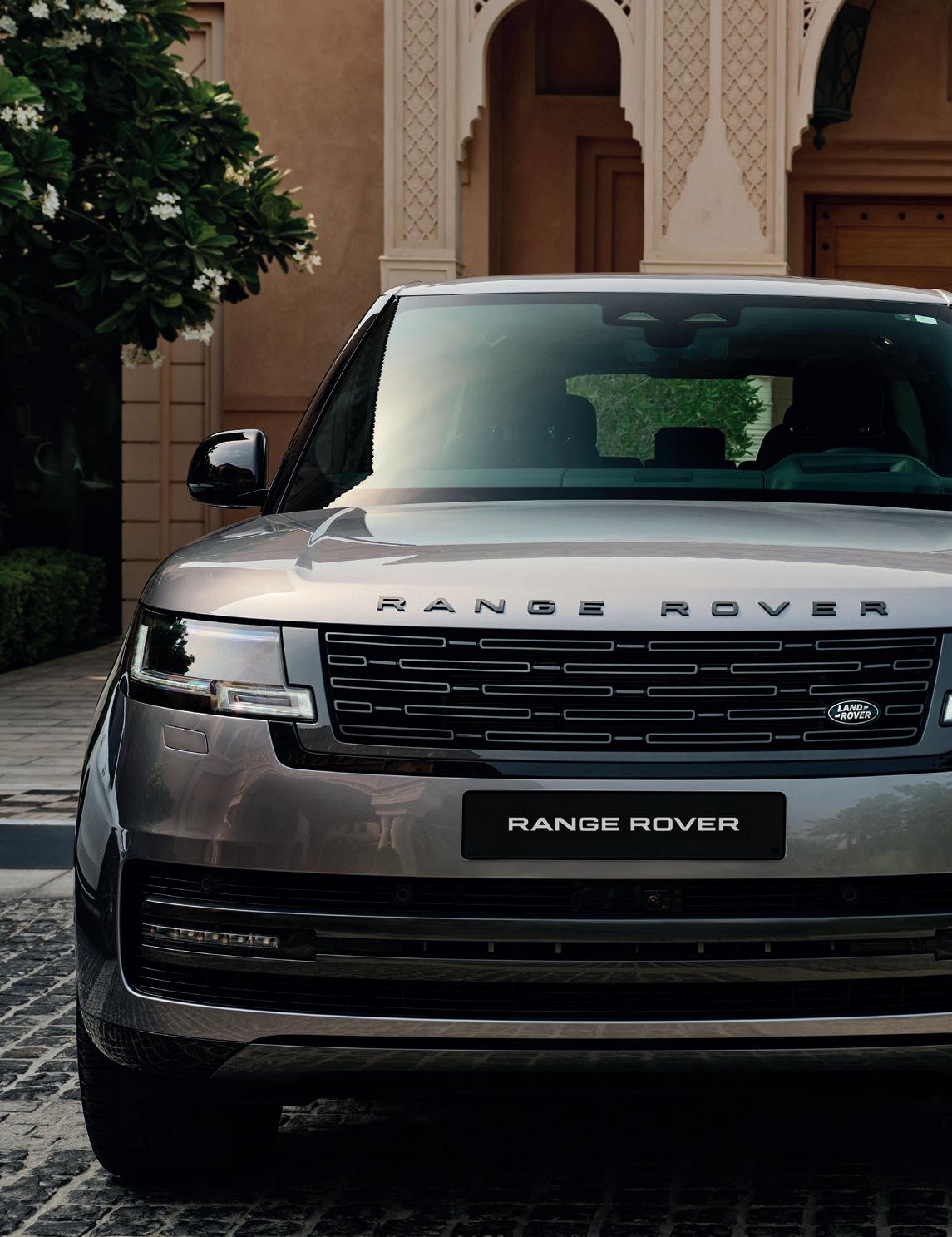
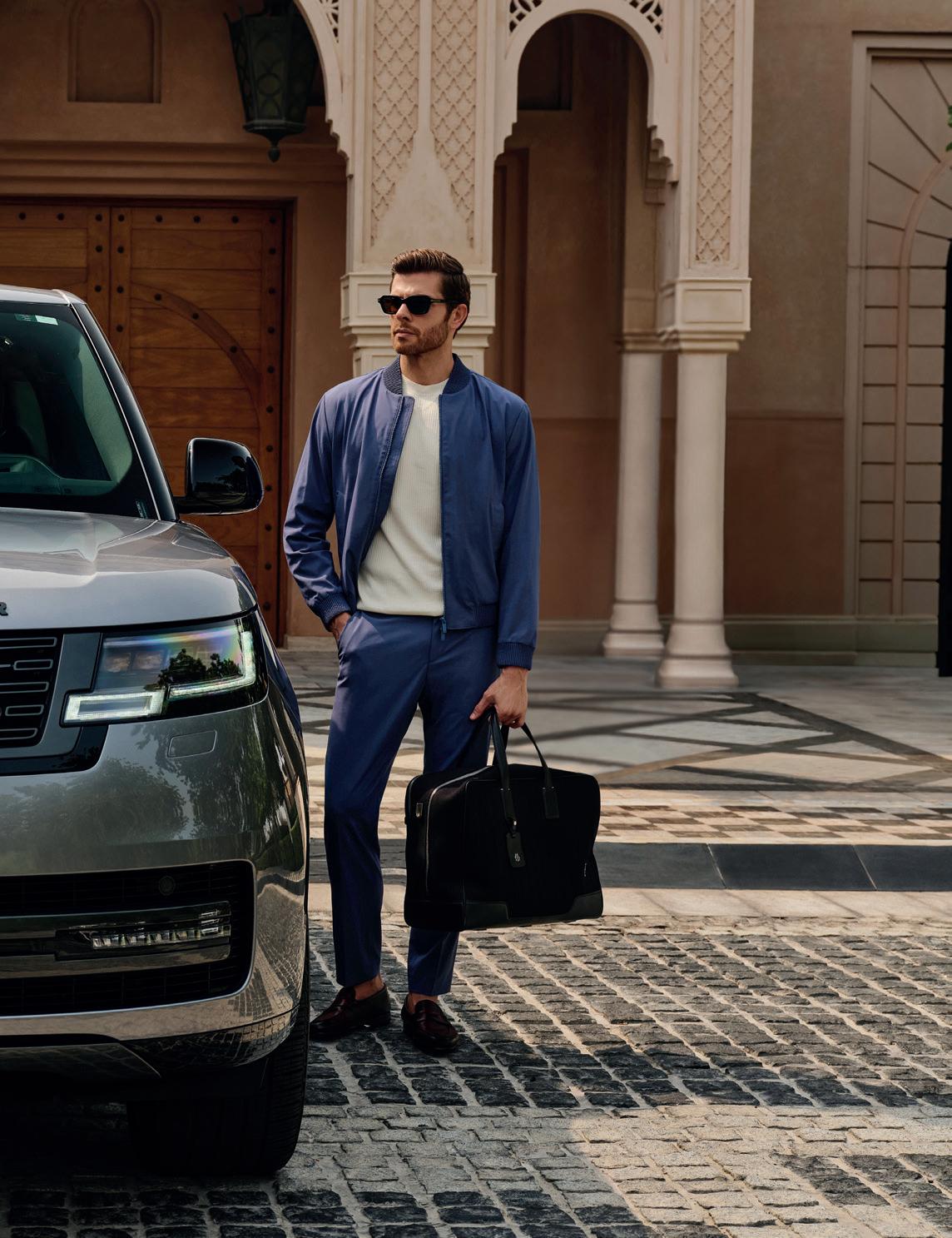
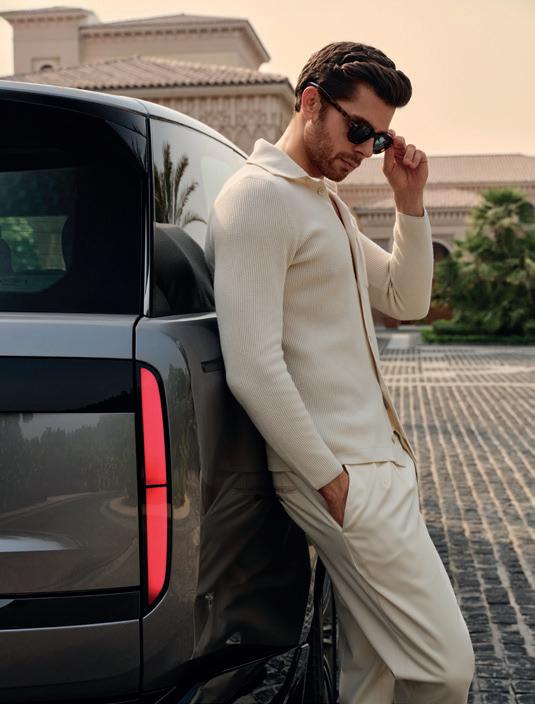

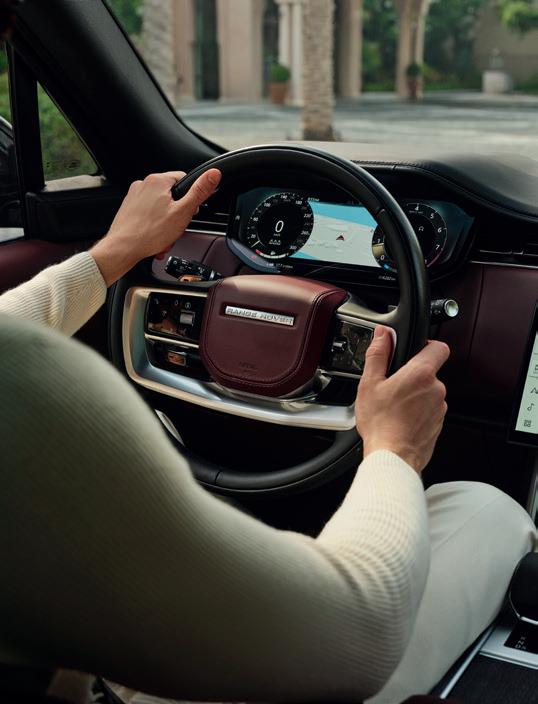



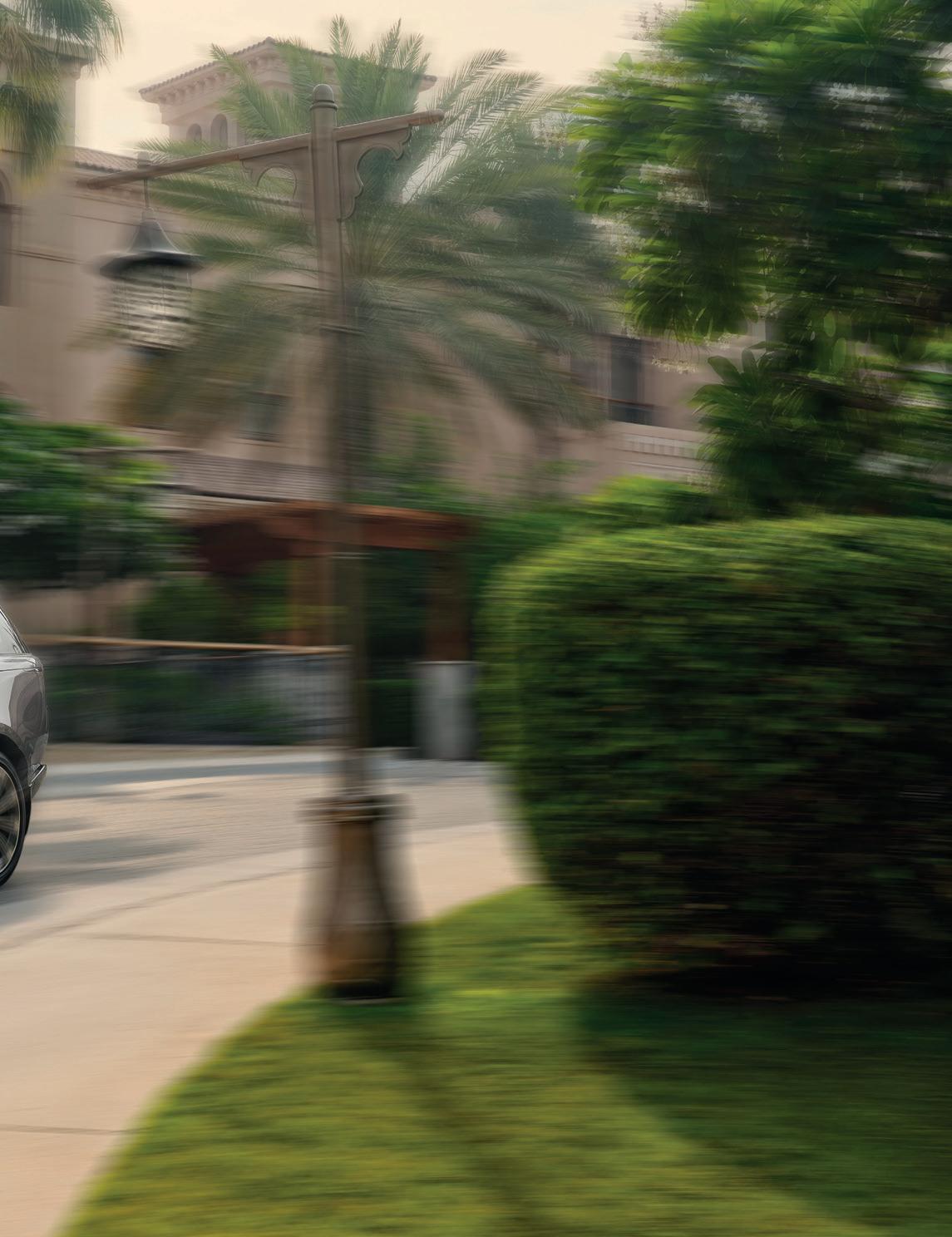

Stylist Chloe Bosher
Page 1
Top and trousers: Brunello Cucinelli
Shoes: Santoni
Sunglasses: Tom Ford
Pages 2 and 3
Jacket and trousers: Hugo Boss
Shoes: Santoni Bag: Rimowa
Sunglasses: Salvatore Ferragamo
Page 4, from top to bottom
Top and trousers: Brunello Cucinelli
Jacket, t-shirt and trousers: SEASE
Sneakers: Born Outside Italy
Bag: Brunello Cucinelli
Sunglasses: Tom Ford
Page 5
Top and trousers: Brunello Cucinelli
Sunglasses: Tom Ford
Page 8
Top and t-shirt: SEASE
Sunglasses: Tom Ford
Ever since her breakout role in Euphoria, it seems like everyone everywhere is talking about Sydney Sweeney. Lex Martin meets her to find out why
INTERVIEW: LEX MARTIN
WORDS: JOHN THATCHER

The countless stories of demanding actors that emerge from movie sets tend only to be of prima-donna behaviour and irrational requests. In the case of Sydney Sweeney and her latest film, Immaculate, her request was simply strange. “One of my big requests was that by the end of this film I want to be drenched in blood. However I get there, I want it to be fun and exciting and gory.”
Immaculate, which opens in the UAE this month, is all three and sees Sweeney’s stock continue to rise. Not that Sweeney’s request was entirely out of character. She’s previously played a teenager possessed by evil spirits in the horror film Along Came the Devil (2018); a member of Charles Manson’s sadistic cult in 2019’s Once Upon A Time In Hollywood; and took on the dark role of Eden
Spencer in The Handmaid’s Tale (2017). You can also trace the start of her acting career to the independent horror flick MD: Zombies of Mass Destruction (2009), while the New York Times judged her character, Olvia, in satirical drama The White Lotus (2002) to be the ‘scariest girl on TV.’
Sweeny’s dalliance with the dark side dates to nights watching such films as Nightmare on Elm Street and Rosemary’s Baby with her father, a big fan of horror. Is there anything she’s fearful of? “I have a phobia of needles. I don’t know where it comes from. I have had it since I was little and it is not like ‘I’m scared, I am screaming’. It’s like a real phobia, and I have not been able to figure out how to solve it.”
While shooting the recent rom-com, Anyone But You (2023), there was also a frightening incident involving a Huntsman spider, which actually bit
her in the scene where she is supposed to simply act distressed by its presence. Anyone But You, which she also co-produced, was a box office smash, pulling in over $200 million globally having been made on a budget of $25 million. But it was the drama series Euphoria (2019) that paved the way for such success, her character Cassie running the gauntlet of teenage turmoil. When the script landed with Sweeney, she was overcome with emotion. “I started crying on the phone because of how beautiful and important this character was going to be to me, and I knew I had to take it,” she told Variety How does she relate to her character in Immaculate, Cecilia, a nun who joins a remote convent in the Italian countryside? “The main thing that I related to was Cecilia’s journey for a purpose. That was the whole reason she was going to a convent, because
‘ I As a woman in my mid-20s, I am constantly searching for what I am supposed to be ’
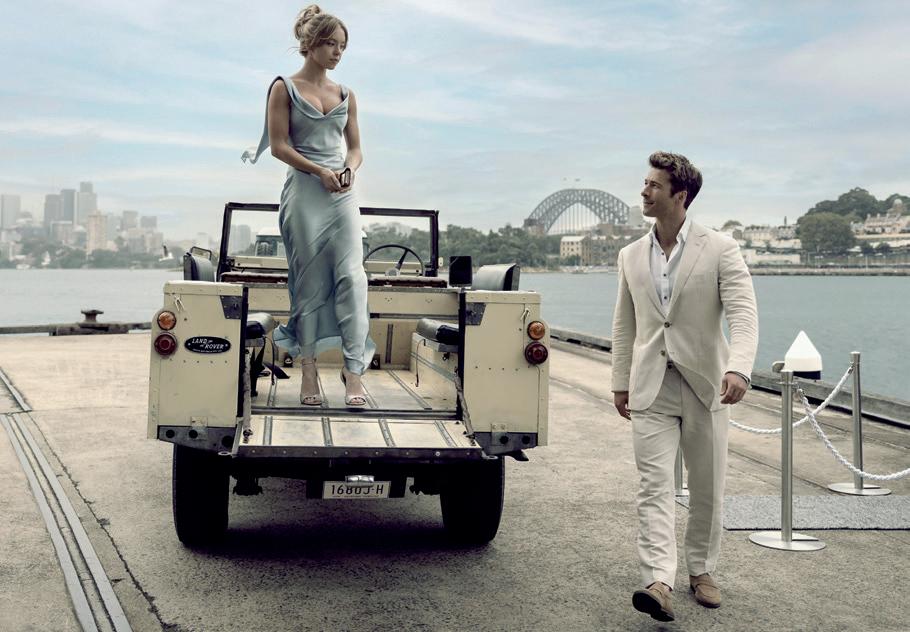


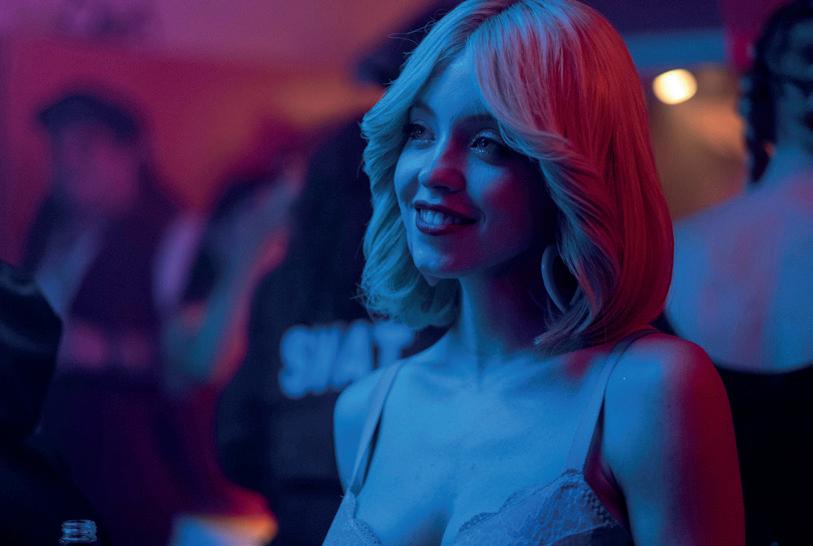
‘ I can’t control what people think, what people say, what people write about me ’
she was looking for meaning in her life and her place amongst others. As a woman in my mid-20s, I am constantly searching for what I am supposed to be, who I am supposed to be with, and what I can give to the world. That was my biggest relation to her.”
Sweeney’s early life was far removed from the horrors her characters often endure. Born to a lawyer mother and healthcare professional father, she grew up on the border of Washington and Idaho in an idyllic lakeside house with no internet, where her family had lived for five generations. Her parents encouraged her to fall in love with as many things as possible, and so Sweeney indulged in everything from skiing and golf to mixed martial arts and ballet. Then she tried acting: “This is my passion and my love.”
In 2020, Sweeney’s love for the industry extended to launching the production company Fifty-Fifty Films, in a bid to create opportunities for female authors, screenwriters, and producers. It also gives her scope to work with whom she likes on the production side of things. “It’s really important to me
to work with people that listen to you, support you, and want to make sure that your voice and opinion are heard. Because you’re on a set for 10-12 hours a day, I love surrounding myself with friends and people that I love working with. You are also with this group of people months beforehand; prepping, location scouting, and then you are working together night and day. You barely sleep because of working on shot listing, rewriting scenes and changing things as you figure out all the elements. And then you start promoting the movie.”
By means of further explanation, Sweeney’s producing partner on Anyone But You and Immaculate was her fiancé, Jonathan Davino.
“I have learned so much. Immaculate was like my first baby in a sense of being able to go after a script, put an entire team together, go into production and learn the entire mechanics of making a film from the ground up.”
As impressive as Sweeney’s careerbuilding has been to date, she is not without her detractors. Earlier this year, seasoned Hollywood producer
Carol Baum commented that Sweeney is “not pretty” and “can’t act”. In response, Teddy Schwartzmann, a fellow producer on Immaculate, hit back: “I’ll enlighten Ms Baum that twotime Emmy nominee Sydney Sweeney is not only one of the most talented actresses I’ve worked with, but also incredibly smart, kind and humble.”
She’s also very level-headed. “It starts a conversation, that’s social media," she says. "I can’t control what people think, what people say, what people write about me. So I just keep doing what I like to do and finding things that excite me, make me feel good and challenge me in new ways.
“I know everybody has their own opinions about things. I can’t force people to love something or not. It was the same with Anything But You. I produced that and put the whole team together. Critics didn’t love it, but the audience did.
“It’s important to share happiness and try and make everybody’s days a little bit better. I just have to keep being myself, that’s it.”
We couldn’t agree more.
Originally finding fame as a classical harp soloist, Markus Klinko then became an acclaimed celebrity photographer, working with the likes of David Bowie, Beyoncé and an up-and-coming Kim Kardashian
WORDS: CHRIS ANDERSON
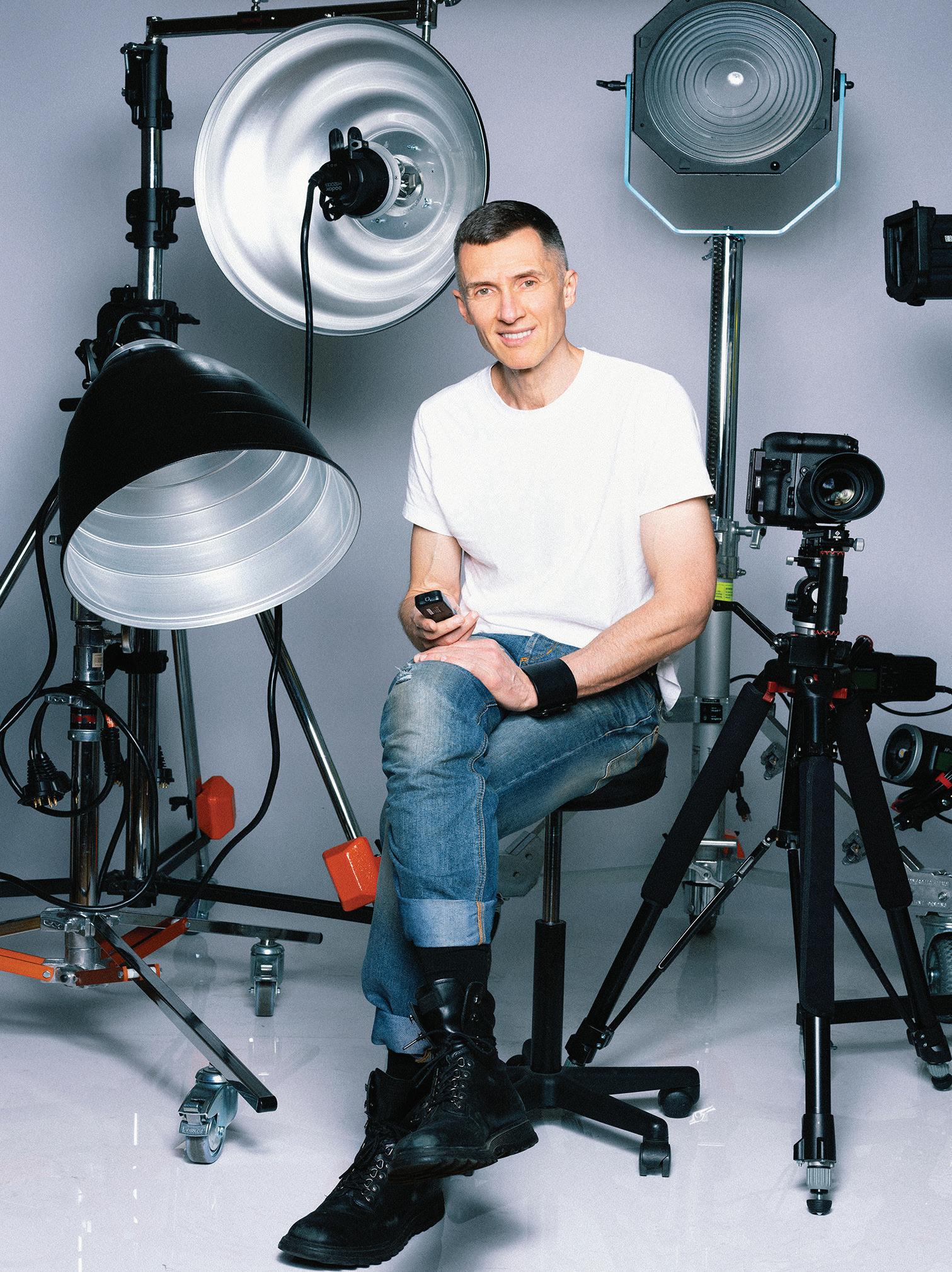
Speaking to photographers about their most famous images, it can often be fun to learn their trade secrets – the story behind the shot, and the little interventions that led to such iconic work. “Yes, she’s wearing my jeans there,” says Markus Klinko, referring to the cover of Beyoncé’s debut solo album, Dangerously in Love, released in 2003. “I’d photographed her for a magazine when she was in Destiny’s Child a few years before, and she asked me to do the album cover. She had seen a campaign I’d shot with [French model and actress] Laetitia Casta, lying on a diamond-studded spider’s web, and wanted something similar, but smaller. We had a diamond top, but with a skirt it looked too ‘red carpet’. I suggested jeans, but she didn’t have any – so she wore mine!”
Beyoncé’s first album went on to win five Grammy awards. “I’m often asked if I wasn’t wearing any trousers during the shoot,” reveals Klinko, expertly anticipating the next question. “But no, I had a spare pair with me. It was her mother, Tina, that was styling the shoot. They returned my jeans to me a few months later. They had been cleaned, and they were nicely wrapped with a ribbon.”
The Beyoncé image is one of many to be featured in Klinko’s new Paris exhibition, Bowie, Beyoncé and Beyond, at the Bel-Air Fine Art Gallery, Le Royal Monceau from September 26. “It’s like a career retrospective, featuring my most famous works,” the photographer reveals. “The shoots I’ve done with Beyoncé, Britney Spears, Jennifer Lopez, Janet Jackson, Lady Gaga, Mariah Carey, David Bowie –all recognisable moments from the 2000s – and a lot of recent images as well, featuring newer celebrities like Ice Spice and Billie Eilish.”
Many of the names reeled off by Klinko are musicians, which must seem like no coincidence, considering the photographer, born in Switzerland of French-Hungarian descent, was once a recording artist himself. “I was a classical concert harpist, and I studied at the Paris Conservatoire, then signed with EMI Classics,” Klinko reveals. “I won awards, recorded albums, and was featured in magazines. Then, in 1994, aged 33, a hand injury prevented me from playing. I decided to become a photographer instead. As

‘ With celebrities, there are billions of photos of them created every day, so I see my job as making that lasting masterpiece ’
a musician, I’d been photographed, so I had that experience, but I’d never owned a camera. I was always very disciplined, so I switched from practicing the harp for nine hours a day to studying photography instead, all with the same intensity.”
Beyoncé is name-checked in the title of Klinko’s latest show, alongside another icon, David Bowie. “The shoot with Bowie happened before Beyoncé, in 2001, and was a real gamechanger in terms of my career,” he says. “I’d been commissioned by his wife, Imam, to shoot the cover of her autobiography, I Am Imam, and when she visited my studio in Los Angeles to choose the final image she brought him along. I hadn’t expected him at all. He took one look at my work, and completely out of the blue asked if I would like to shoot the cover for his next album.”
This would be Bowie’s 23rd album, Heathen, released the following
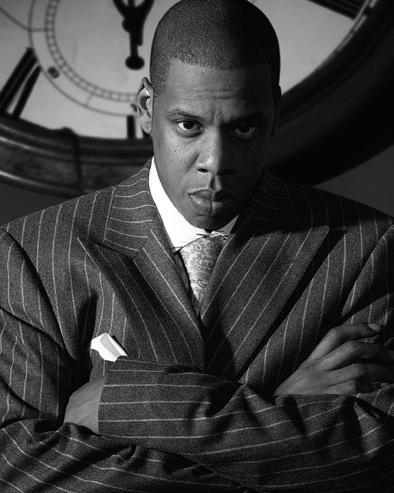
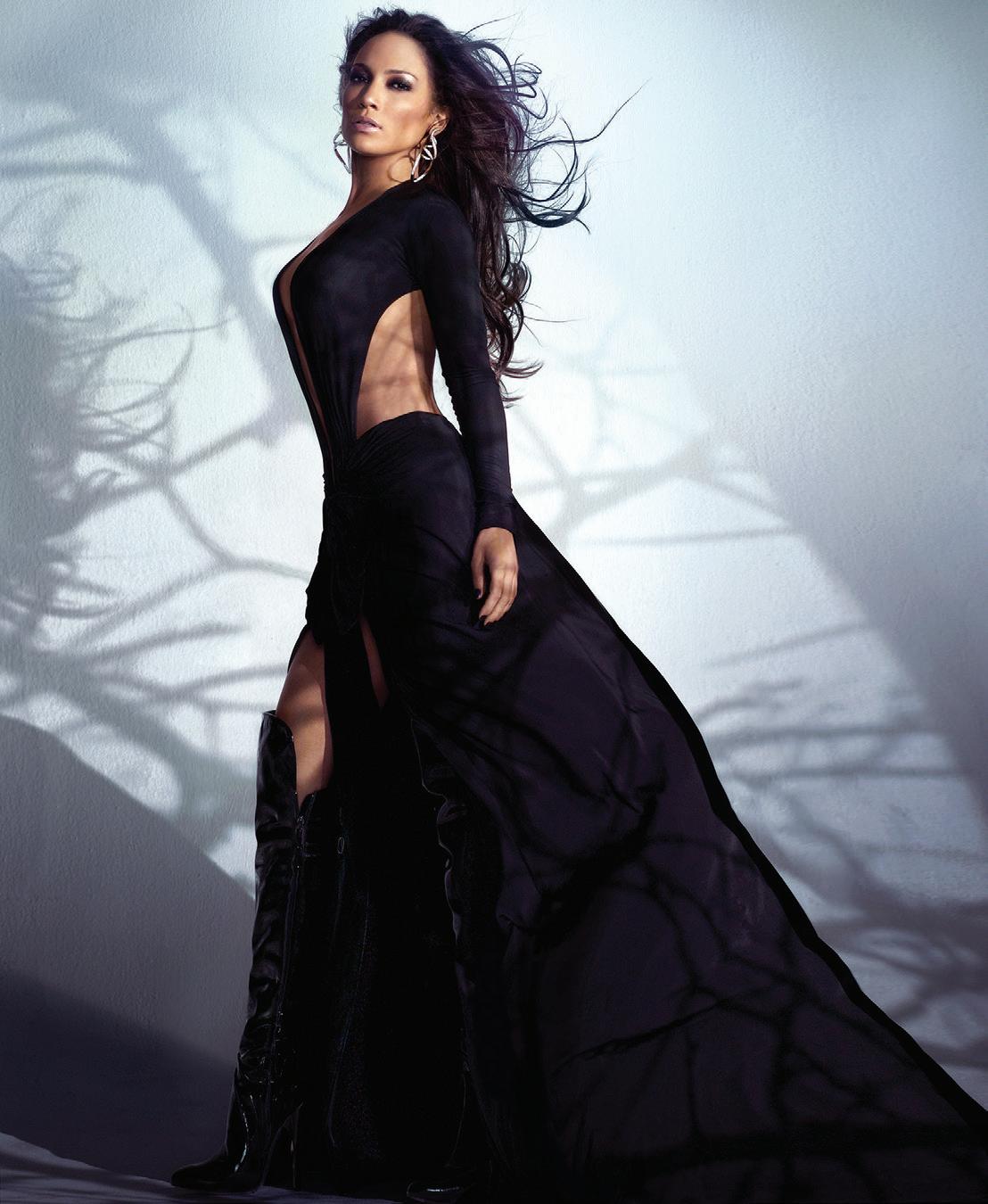
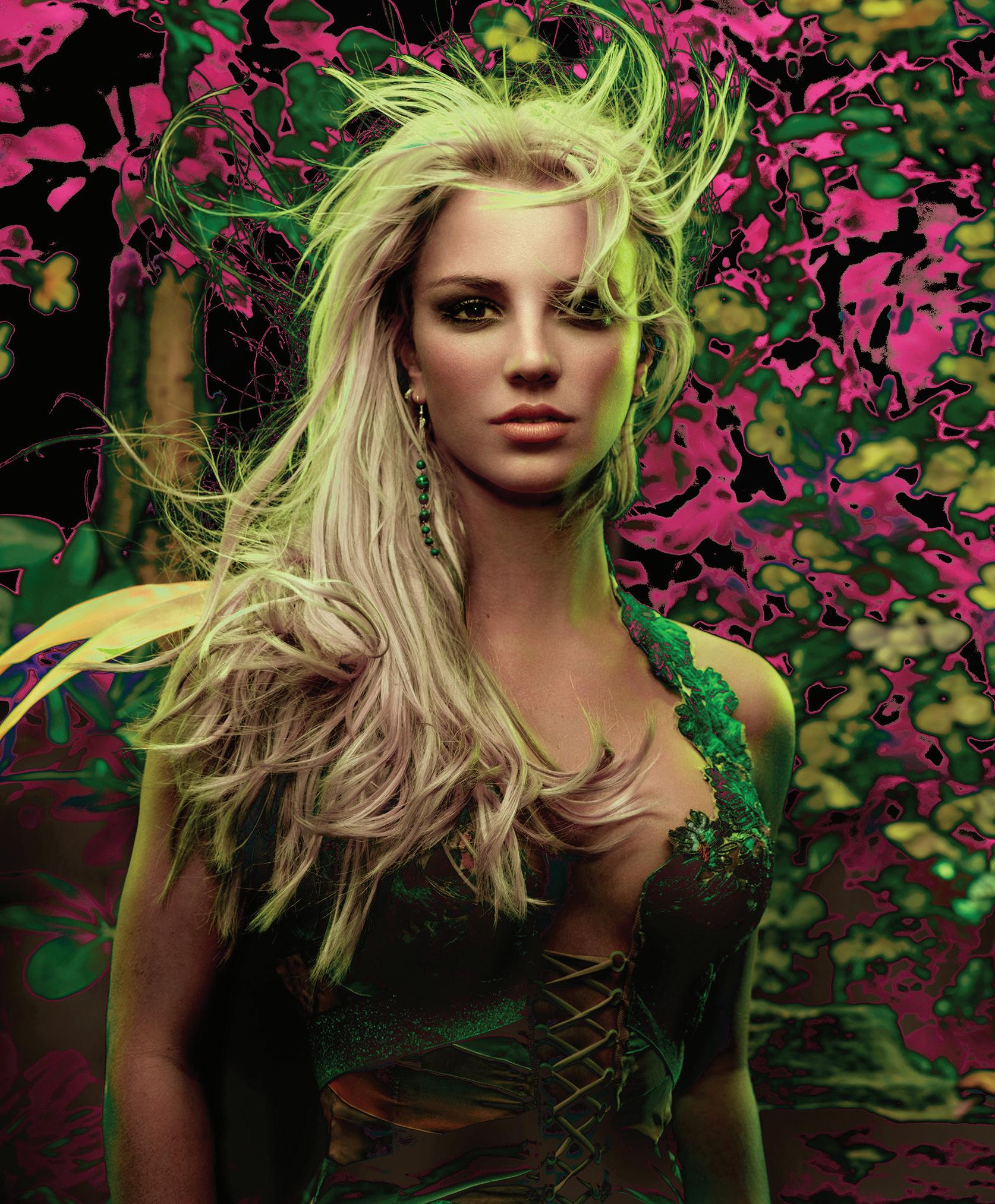


‘ Beyoncé had to wear my jeans for her album cover shoot’

year, featuring Bowie in a suit on the artwork, facing to his right, with blank eyes. “I remember, 9/11 happened shortly after we met, so there was a bit of a break, but then he called me, and invited me to his recording studio to listen to the album,” Klinko recalls. “We talked about it, and he had some specific ideas, but still gave me a lot of creative freedom. It was a wonderful collaboration.”
There are so many images of Bowie in Klinko’s portfolio, it suggests a lengthy working relationship. “Nope, everything you see here was shot in a single day,” adds Klinko. “There were more than 50 images, all amazing, with the animals and effects added in postproduction. An incredible shoot, and the extent of my work with him – until he called me in 2013, and asked if I would direct a music video, Valentine’s Day, for him. But to have someone like David Bowie choose you, and so early in my career, it’s a huge validation. And that particular shoot, the images we did, they are so loved by his fans, collectors, galleries, and so on.”
Klinko also shot the album cover for Mariah Carey’s The Emancipation of Mimi in 2005. “It’s one of the


photography categories that has the longest staying power, more than a magazine cover or an advertising campaign, because it defines a whole era in pop culture,” he reflects. “And I think it suits my creative approach, producing these classic, timeless images. With celebrities, there are billions of photos of them created every day, so I see my job as making that lasting masterpiece. I look to Greek mythology sometimes, the idea of gods and goddesses, which celebrities are seen as a modern version of, so I’m presenting this fantasy image. Much
of my work is created on assignment, but takes on that lasting appeal, like a work of art, over time.”
A recent magazine shoot with Paris Hilton appears to harness this quality, with images of other celebrities, such as Anne Hathaway, Kate Winslet, and Kim Kardashian, following suit. As well as the upcoming exhibition, photos such as these can be seen in books and museums and galleries all over the world, with Klinko starring in a new TV documentary series (currently filming) and the recent recipient of the Outstanding Achievement in Photography, presented to him at the Hollywood Beauty Awards. But just as there are those Klinko has worked with, there are many he is yet to. “Sydney Sweeney would be great,” he says. “Also, I love Taylor Swift. And Madonna I’ve never worked with, but I’d like to. I always say, the more you learn, the more you feel you still have left to learn, and no matter how many celebrities I shoot, there are always new ones coming along.”
Markus Klinko: Bowie, Beyoncé and Beyond, Bel-Air Fine Art Gallery, Le Royal Monceau, Paris, September 26-October 26. belairfineart.com
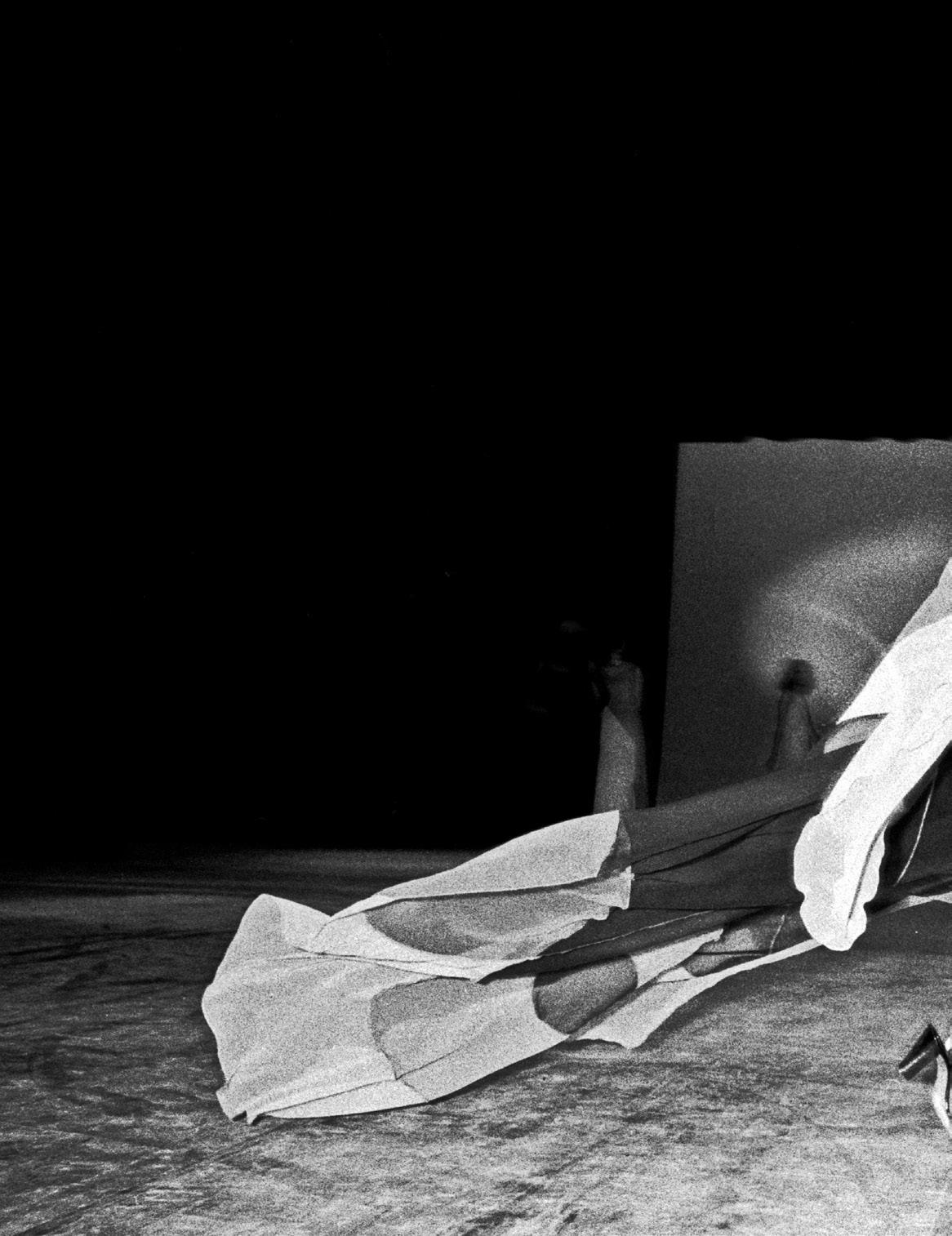
In 1973, a charity fashion show pitted five French designers against five from the USA. What was billed as frivolous fun became a landmark event for fashion
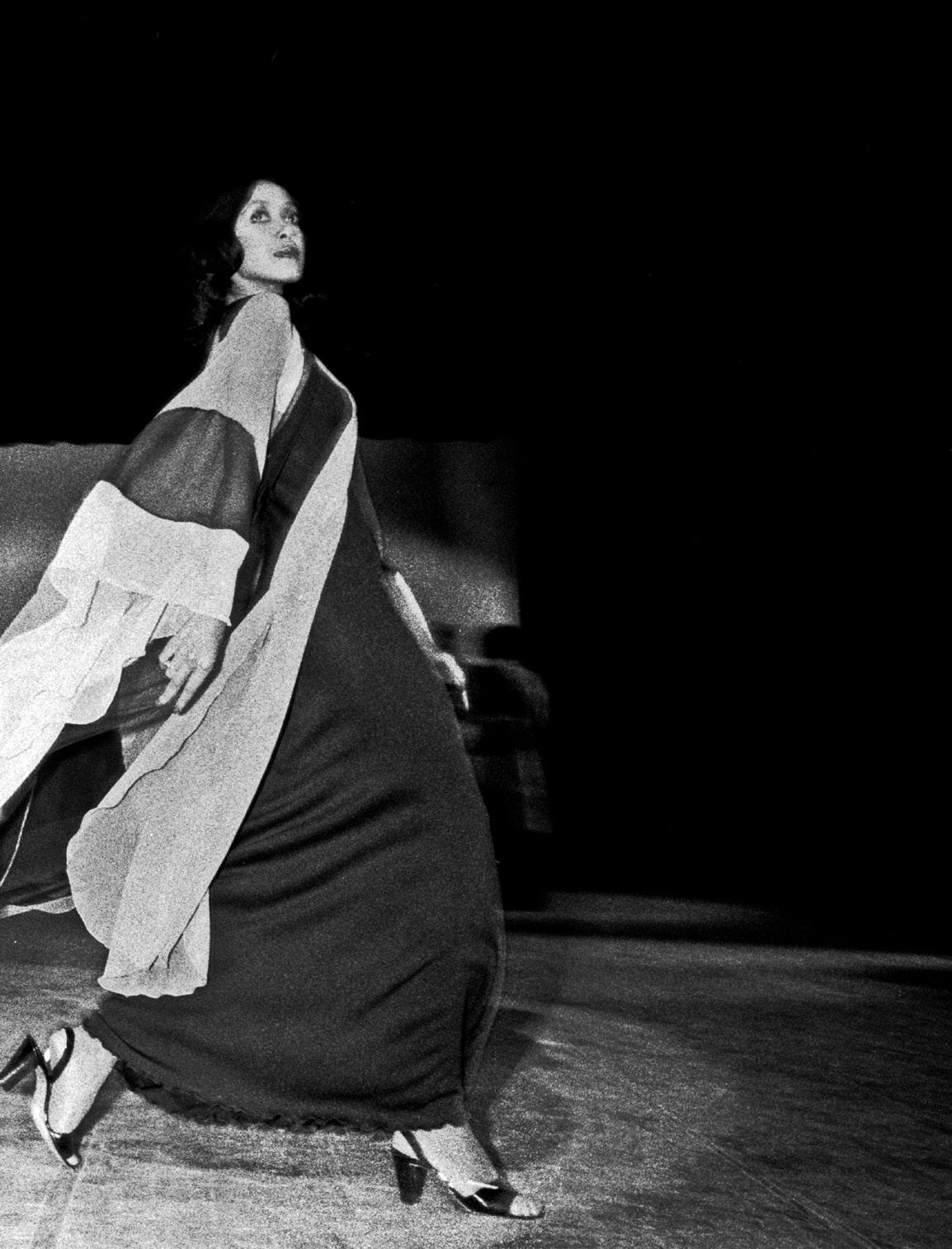
With good reason, the French had long considered themselves untouchable in the world of fashion by the time the Seventies rolled around. They led the way, the rest of the world followed. Then, in 1973, came what was dubbed the Battle of Versailles, a charity fashion show staged to raise funds for the crumbling palace. It would pitch five of France’s celebrated couturiers – Pierre Cardin, Hubert de Givenchy, Yves Saint Laurent, Emanuel Ungaro, and Marc Bohan for Christian Dior, against five invited designers from the US: Bill Blass, Stephen Burrows, Oscar de la Renta, Halston, and Anne Klein. Both countries would flaunt their fashions as part of extravagant, separate shows for a ticket-paying crowd that included Princess Grace of Monaco, Elizabeth Taylor, Andy Warhol and a whole host of jet-setting socialites. The French show ran for over two hours and included a performance by Josephine Baker, a live orchestra and the odd animal (there was more than one rhino). For America, Broadway star Liza Minelli performed at the opening and closing of each of the five designers’ segments, the show a short, sharp thrill at just 30 minutes. It was meant to be a night of frivolous, fundraising fun, but what transpired after the Americans’ ‘win’ – on account of their more youthful, modern approach that was completely at odds with that of the French – has been the subject of several books and documentaries. “Looking back, it’s clear that indeed the event was only fractionally about dresses, which is why it has continued to be analysed and its significance has been best appreciated in hindsight,” said Laird BorrelliPersson for Vogue. “Versailles opposed the new world belief in meritocracy and the old world’s rigid, hierarchical, often monarchical class system. It also highlighted the divide between commerce (Seventh Avenue) and art (haute couture); ready-to-wear (which was aligned with more casual and liberated modes of living for women) and exclusive and time-intensive madeto-order. More than that, the event reflected some of the diversity of the US, as ten of the 36 models and one of the five designers on the American team were African-American.”
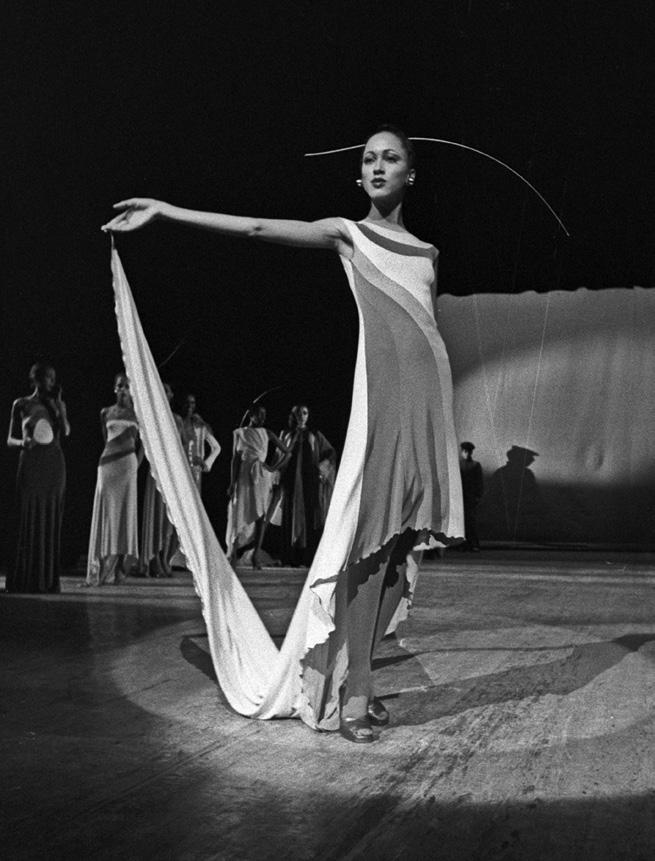
There to witness it all were acclaimed photojournalists Bill Cunningham and Jean-luce Huré, whose intimate portrayal of the evening is now the subject of a new book, The Battle of Versailles: The Fashion Showdown of 1973 , published by Rizzoli. Largely unseen previously, the images capture the behind-the-scenes drama, clothing, iconic models, and glamorous guests at this historic show. It also includes insight from Liza Minnelli and model Pat Cleveland.
“The French show lasted almost two hours. Yet in just 30 minutes the American’s simply overwhelmed the audience and themselves. Models rushed off the stage crying, ‘They Love us. They love us!’ As Anne Klein would later say, ‘I knew we won the Olympics,’” reflected Cunningham in the book. “The moment Liza Minnelli entered the stage singing ‘Bonjour Paris,’ followed by over thirty models, including fifteen that were Black,
was unlike anything the French had ever seen. The most sophisticated of audiences roared and applauded their approval. The fancy programs were actually flown into the air.”
The book also contains excerpts from Cunningham’s private diary, which detailed the event. “The ‘catastrophe’ Bill writes about in his Versailles diary was that the rules of high society were tumbling down,” writes Pat Cleveland in the book. “Before, you couldn’t go to a couture show unless you were invited, as a lady of society. You didn’t have ready-to-wear. But Bill had been following it, going to the couture shows in the fifties with those women from Chez Ninon, the ones who Chanel allowed to make the pink suit Jackie Kennedy wore in Dallas. It was real Dior and real Balenciaga in the fifties. So Versailles was like a tsunami for him. The tower was falling, and he was watching it as it was tumbling down right before his eyes.”
Liza Minnelli, who pens a foreword for the book, hails the impact of that night. “In the kaleidoscope of art, entertainment and fashion, there are events that not only define a career, but also herald a cultural shift. The 1973 Battle of Versailles is one such glittering waypoint — an event where fashion, music, and art collided in a spectacle of transatlantic glamour. It was a night that saw American designers step out from the shadow of their European counterparts; a night where colour, energy, and democracy in design took to the stage and left an indelible mark on history. My heart swells with gratitude and great pride whenever I reflect on that magical experience.” She was, however, fraught. “We were all so scared! We knew our approach was different — bold. History has proven that the electric spirit of Versailles epitomised and revolutionised art, fashion and beauty in glorious ways.”
Mark Bozek, the author of The Battle of Versailles, holds the late, legendary New York Times fashion historian and street photographer Bill Cunningham in high regard, meeting him for the first time when interviewing him for the TV station he was working for. The interview was supposed to take ten minutes. Over three hours later, Bozek had heard Cunningham’s life story, the tale of Versailles sticking in his mind and inspiring his own documentary. On its 50th anniversary last year, Bozek reminisced by scrolling through hundreds of photos and contact sheets of the event from Bill’s archive. “I realised that, not only had he photographed the show, but he had also documented almost every step of the journey — the plane ride from JFK to Paris with many of the models; the rehearsals for the show; the dinner party given by Halston in honour of Liza Minnelli; and countless moments from backstage and the gala that followed. I was immediately keen to see the photos that his French counterpart, Jean-luce Huré, had taken at Versailles.
“For obvious reasons, I liked the notion that the book would have an American photographer and a French photographer. Contrary to the title of this book, there was no such ‘battle’
‘
The French show lasted almost two hours. Yet in just 30 minutes the Americans simply overwhelmed the audience and themselves ’
between these lifelong friends and passionate pursuers of fashion history.”
It’s a shot of pioneering model Pat Cleveland by Jean-luce Huré that appears on the book’s cover. “The photograph that Jean-luce took of me in Stephen Burrows is totally judging a book by its cover. It’s fierce and powerful and just says ‘bonjour – we’re not going anywhere!’”


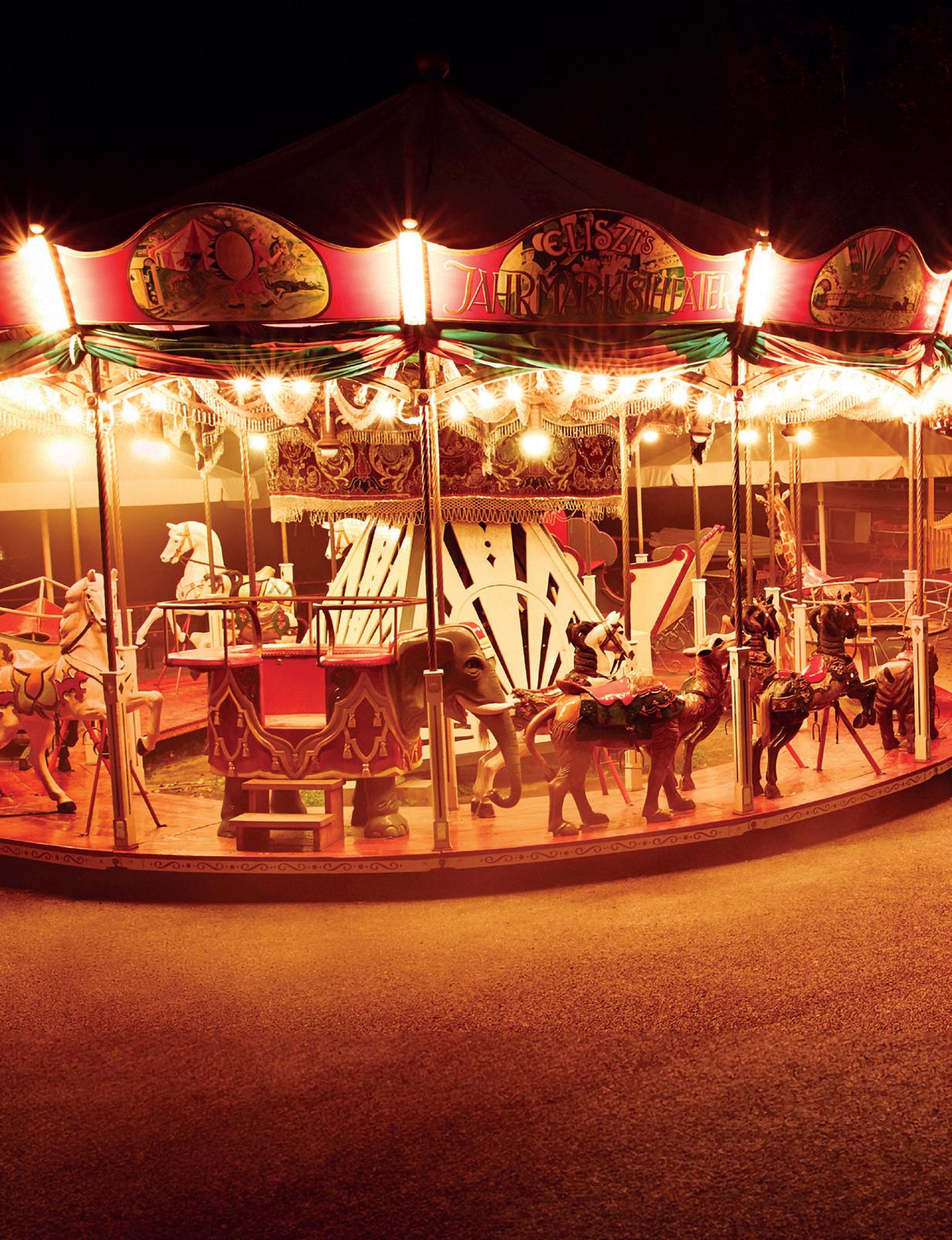
In the year that the Porsche 911 Turbo celebrates 50 years, a new book delves into Porsche’s legendary evolution, from past icons to modern marvels
WORDS: CHRIS ANDERSON



The Porsche 911 Turbo is an unbelievable 50 years old this year. Introduced in 1974, it showed that the already-incredible Porsche 911 could be taken a stage further, much to the delight of the many enthusiasts that had followed the German car brand, founded in 1931, through several decades. Those same followers would no doubt be pleased to learn that a detailed history of the marque has just been compiled by journalist, artist and media maker Michael Köckritz, who has methodically compiled photos and information for a new coffee table book, simply entitled The Porsche Book, as an essential must-have for Porsche enthusiasts.
Who knows what founder Ferdinand Porsche himself might have thought, who started the company back in the early 1930s, if he were to leaf through the pages of a book concerning his own legacy? A long-standing figure in the German automotive industry, a contract to build a race car, the P-type, for the Auto Union, and the designs for what would eventually become the Volkswagen Beetle,


‘The appeal of a car like the 1963 Porsche 356 C is undeniable ’
helped to bring the company to life.
While the 911 and 911 Turbo were popular cars in their time, there have been many others, as detailed in the book. For example, there is the 911 Targa, introduced in 1964, and a response to the proposed ban of convertibles in the US market, fitted with an anti-roll bar as standard.
And as memorable cars go, who could forget the legendary Porsche 924, introduced in 1976? With a water-cooled four-cylinder front-mounted engine, and a trans-axle transmission sending the power to the rear wheels, this was the brand’s entry level. In the 1976/77 financial year, the 924 accounted for almost half of Porsche’s total vehicle sales, and by the time production was ended in 1988, 150,684 units of the model had been built. There was the 928 as well, and then the 944, a response to fluctuation in oil
prices, which by 1983 accounted for 51 per cent of Porsche’s total vehicle sales. And today, you have the plug-in hybrid Cayenne and Panamera models.
There have been more unusual standout models too, like the Porsche 917, introduced in 1969, which won the 24 Hours of Le Mans twice, once in 1970 and again in 1971. It remains a firm favorite among motor racing enthusiasts.
The modern Porsche cars are just as impressive, the Cayenne, first introduced in 2022 with Cayenne S and Cayenne Turbo models, is now the brand’s biggest seller by far as the appetite for luxury SUVs shows no sign of being sated. An electric version of it is on the way, following next year’s 718 EV, as Porsche’s roll out of electrified performance vehicles continues.
But while modern refinement is fine, what this weighty tome proves is that the appeal of a car like the 1963 Porsche 356 C is undeniable. Or the 1977 Porsche 928, with its engine derived from a watercooled, 4.5-litre V8 racing assembly made of aluminum, generating significantly less
noise than the air-cooled engine of the 911, and even being hailed as the European ‘Car of the Year’ in 1978 – the first and only sports car to have received that honour.
Not long after, there was the Porsche 956 C Rothmans, designed by Norbert Singer and built by Porsche in 1982 for the FIA World Sportscar Championship.
Other cars to admire as you flick through the book’s pages include the Porsche 956 mounted upside down in a permanent exhibit at the Porsche Museum in Stuttgart, or a Porsche Taycan Frozenberry
Metallic, with coloured accents inside the interior, such as the seat belts, door and dashboard panels, and on the seats — the list of options is always extensive enough to make the car your own.
For those intrigued by Porsche’s journey from its early days to its current achievements, The Porsche Book also offers a captivating exploration of the brand’s evolution, which has seen it achieve success as a racing and lifestyle brand – it details how the Porsche Design brand was born when
Ferdinand Alexander Porsche, grandson of the Porsche founder and designer of the original 911, started his own company, offering fashion, luggage, sunglasses, pens, and watches.
More than just a chronicle of cars, it is a book that celebrates a legacy that continues to inspire and impress, a comprehensive and visually stunning tribute to one of the most iconic names in automotive history.
The Porsche Book by Michael Köckritz is out now. teneues.com
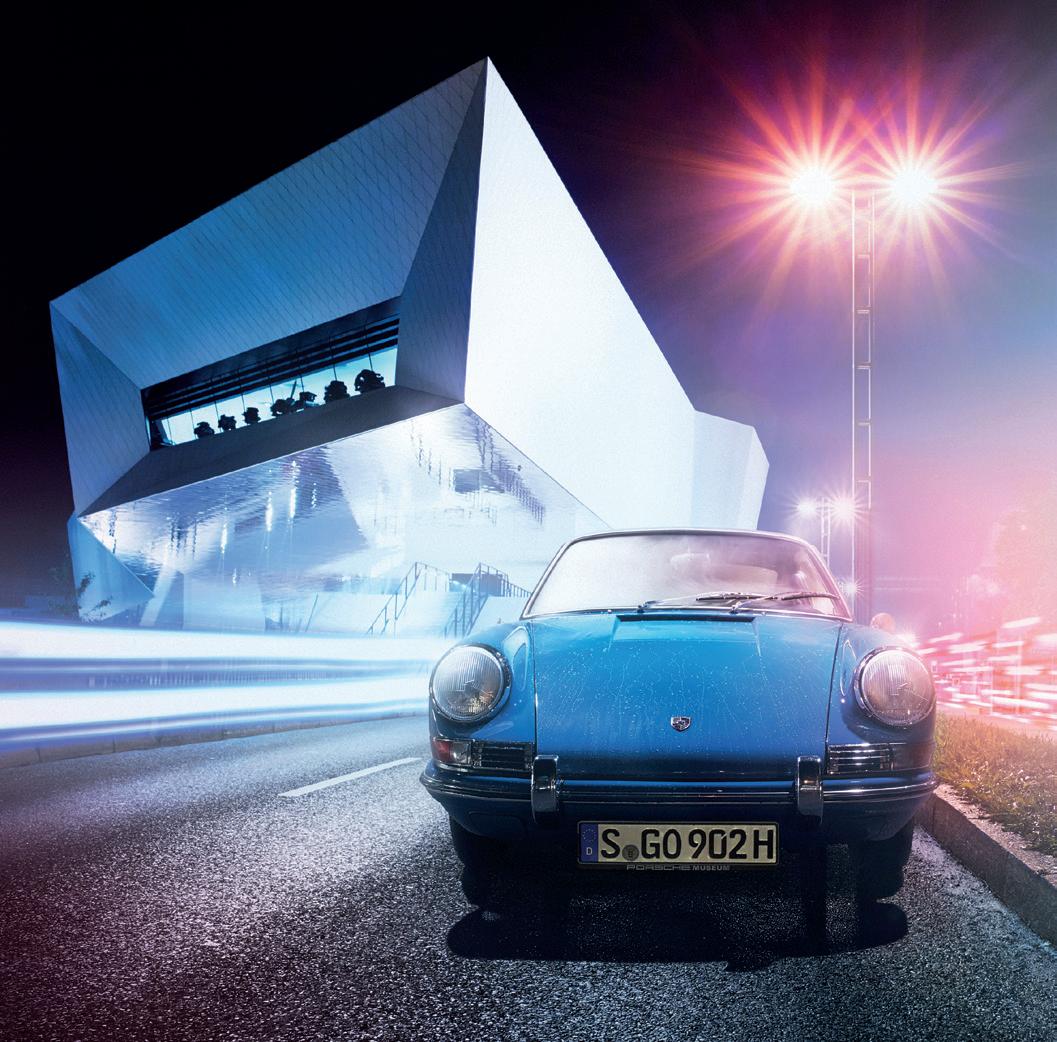

At L’Écrin in Paris diners are required to select what they’ll drink, and only then do the chefs consider the food

Pl enty of wine lovers peruse the wine list before the menu when dining out, but L’Écrin at Hôtel de Crillon in Paris – which reopens on September 5 following its summer hiatus – may be the only place where that is obligatory. In the Michelin-star, 36-seat restaurant within the beautiful hotel where Marie Antoinette once took piano lessons, the head sommelier, Xavier Thuizat, has achieved every sommelier’s dream: making people decide on their wine before their food.
Wine, in a sense, is his birthright. In 1985 the medieval Hospices de Beaune building — now known for the annual charity auction of fine wine from its vineyards — was in transition from hospital (it was founded in 1443 to care for the poor) to museum. There was still a tiny maternity unit with seven beds and little Xavier came into the world in one of them.
Almost four decades later he is at L’Écrin, where the restaurant tables have no place settings — only a large wineglass with a stem but no foot: the hedonistic Marie Antoinette’s preference, apparently, because guests’ inability to set them down made them drink faster. Thuizat fills mine with Pol Roger, explaining that it is the “years of contact between the yeast and the wine, giving rich roasted flavours” that make this champagne so satisfying. (Maybe that’s why Winston Churchill is rumoured to have drunk two bottles of Pol a day.) Thuizat, who this year won the 2024 Michelin Sommelier award, keeps reappearing at the table with beautiful wines. “The kitchen don’t know what they are making until I call and say, ‘This is what the guests are drinking,’” he says. “Everything starts with the flavours, acidity, tannin and alcohol in the wine. From that we create the menu.”
Lots of tannins calls for red meat; a pure, elegant chenin blanc or a young chardonnay without oak both work with the delicate texture of sea bass. Of course, there are risks: “Some people want sauternes throughout the meal. I love sauternes so I’m happy with that, but I do feel sorry for the kitchen.” Mostly, though, he says, the chefs love the challenge — and given his many awards, including France’s best sommelier and Meilleur Ouvrier de France (an
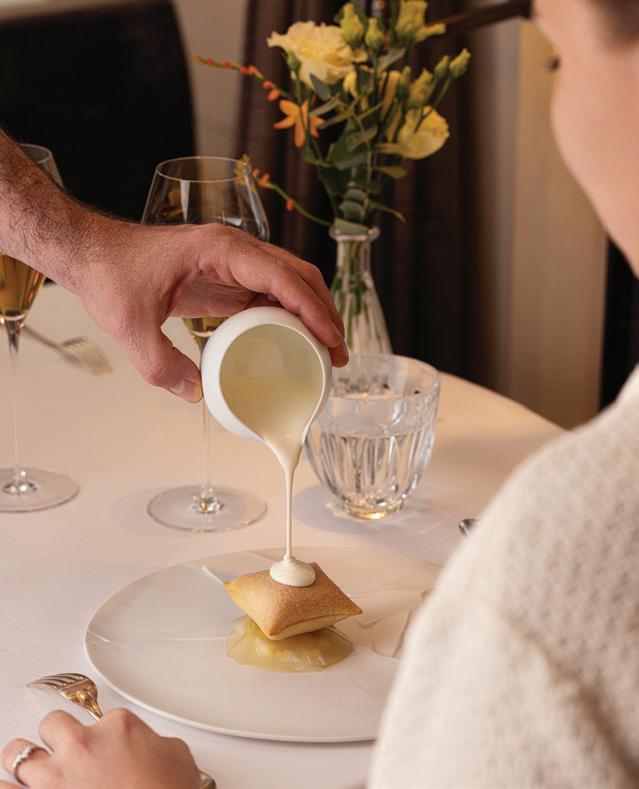
‘ More and more, guests are willing to try things’
artisans’ honour so prestigious that you have to be invited to apply), it’s safe to conclude that he does too.
On Thuizat’s list there are 2,300 wines from 13 countries, and in the famous appellations he prefers to showcase lesser-known talent. Guests can order classic fine wines, “but more and more”, he says, “they are willing to try things”. It helps that he has visited every maker. “If there’s someone you expect to see and don’t, it is because I don’t know the winemaker personally,” he says. He tries about 4,000 wines a year and buys 300 of them. Adventurous diners can plunder the exceptional range — from Corsica to the Languedoc and Spain — by the glass. The food and drink are exquisite. Every sip enhances the dish, and every ingredient is top quality, sourced from across the country. Challans duck, widely considered to be the world’s best; beef from Burgundy; veal from Chartreuse and snails from Touraine. But, perhaps more importantly, fun: for instance, my lemon, bread and ginger-snap pudding was baked in a
clay pot that was smashed open at the table. It came with a serving of Château Climens 2012 from a magnum. Marie Antoinette could not have come up with a pairing more decadently delicious. What excites Thuizat is young talent: Domaine Pierre Girardin, “Burgundy’s rising star”; Mariette Veyssière of Château Quintus, “the new hidden gem of Saint-Émilion”. He oversees wine for Rosewood hotels in Europe (the list at Castiglion del Bosco in Tuscany is stupendous), although each property has its own head sommelier, and he has taken charge of Schloss Fuschl in Salzburg, which opened in the summer with an allAustrian list “dedicated to Mozart”. Can his unlikely birthplace somehow have infused him with a passion for wine? His grandfather did have a vineyard, sold after the war when nobody was buying wine. It was an acre of Bâtard-Montrachet, a grand cru that today would be worth millions of euros. But Thuizat is philosophical; he likes his job, and “now I buy wine from that vineyard for the restaurant”. Surely the best outcome for the rest of us.
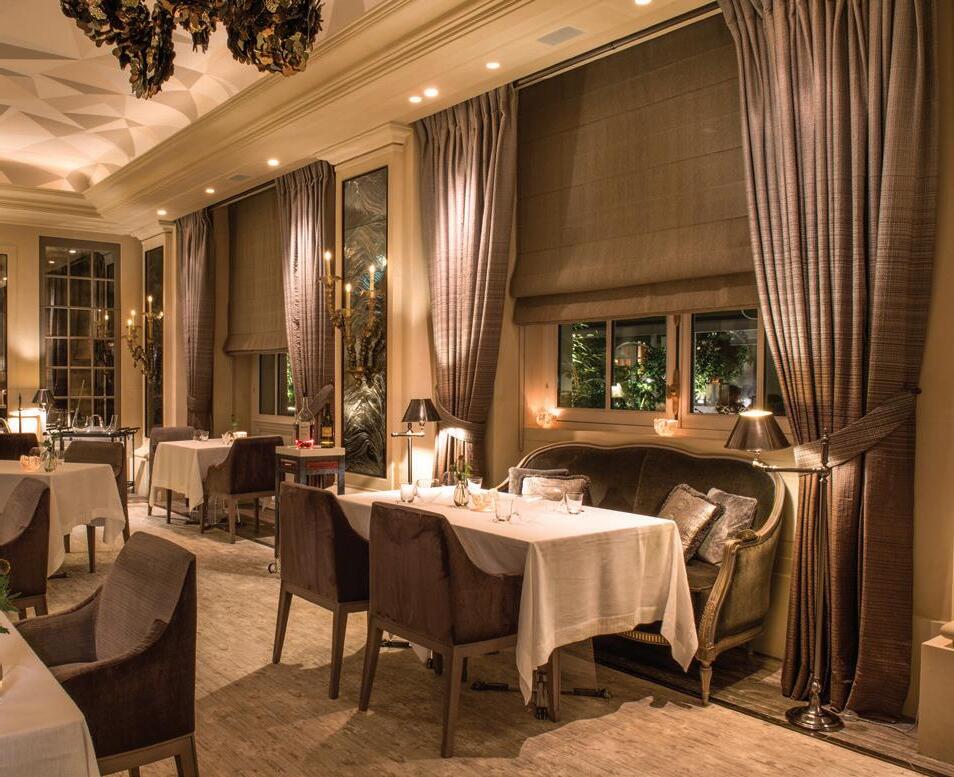
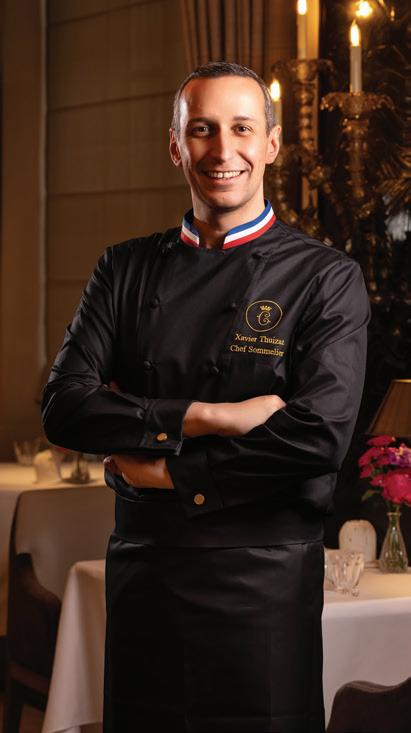
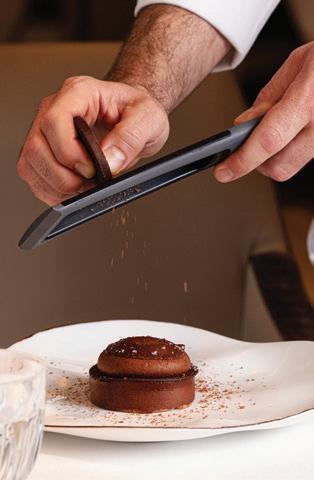

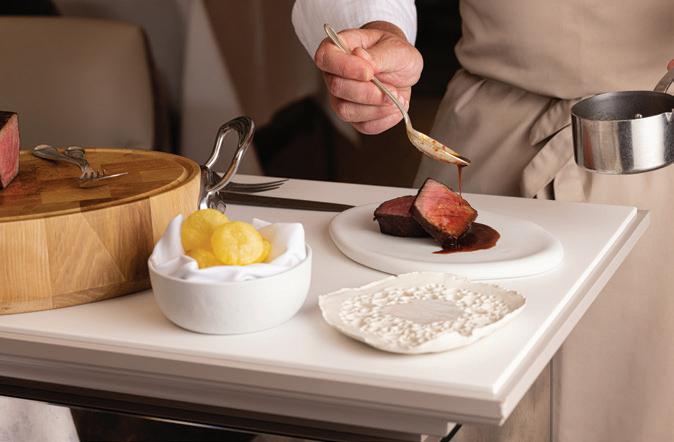
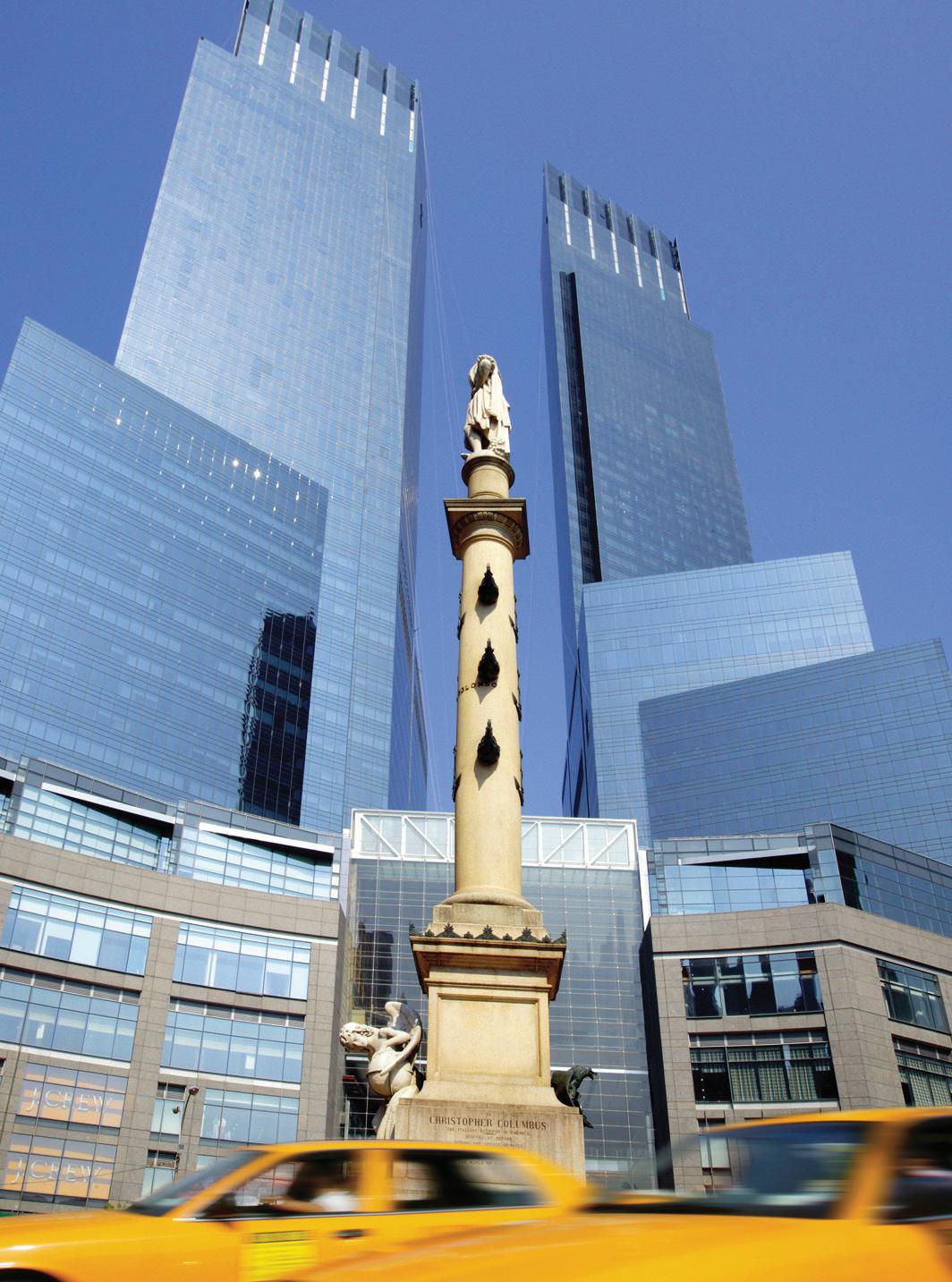
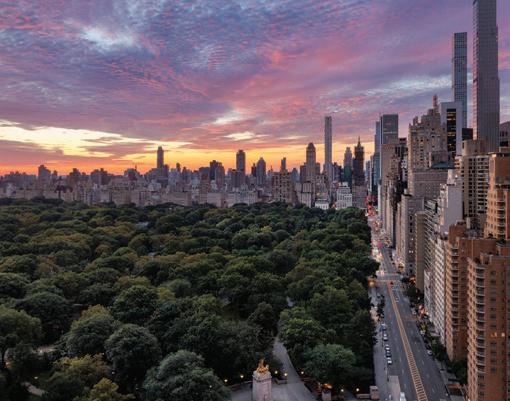
No matter whether you see it on screen, on paper, or in the flesh, a bird’s eye view of New York’s Central Park is something to behold. And there a few better places from which to drink it in than the Mandarin Oriental, New York. It’s there to greet you once the elevator whisks you to the hotel’s 35th floor Sky Lobby, along with the kind of warm reception that’s somewhat of a signature at Mandarin Oriental’s ever-expanding portfolio of properties.
It’s that iconic view – set against the cloud-skimming Manhattan skyline – that’s central to this property, drawing all eyes from the MO Lounge, where an all-day offering takes you from breakfast, when the turkey and egg-laden New Yorkstyle commuter sandwich is the order of the day, right the way through dinner to after-dark cocktails, including the house special, A Walk In The Park, inspired by you know what.
It’s the hotel’s only dining outlet, which may come as a surprise until you learn that it shares a building with the likes of Thomas Keller’s three Michelin-starred Per Se and Masa Takayama’s eponymous three-star sushi restaurant, both of which rank among the city’s finest establishments.
Coupled with exceptional service, what helps ranks Mandarin Oriental, New York among the city’s best hotels are its suites.
It stands on the corner of Central Park at Columbus Circle in Midtown, from where Manhattan is divided into its East and West, North and South, and Upper and Lower areas. This favoured vantage point gives guests of the suites the option of Central Park, Hudson River, or Manhattan skyline views, sometimes all three, as is the case in Suite 5000. It features one-of-a-kind art and highly prized design pieces throughout, including Alben’s Darth Vader Coke Zero and the seven-foot Saida: Chrome, courtesy of artist Steven Naifeh. There’s also a custom-made bed, handmade wallpaper, and a turntable that comes with a record collection curated to represent the varied genres of music that have sprung from New York City‘s eclectic neighbourhoods. In a nod to Mandarin Oriental’s Asian heritage, the Presidential Suite houses a 250-yearold parchment calligraphy book, while on the highest floor of the hotel you’ll find the aptly named New York Skyline Suite, which delivers 360° views and two individually styled bedrooms.
Also high above Manhattan is a 75-foot lap pool, which looks out to the Hudson River, and the excellent spa, where innovative treatment options include one designed to alleviate the issues caused by frequent use of digital devices. The spa also homes its own impressive suites: the VIP Spa Suite offers up stellar views (naturally), a fireplace, bath, and dual massage beds, while the Thai Suite features gold leafing. Further proof, if any were needed, that this is a hotel that has the details down to a fine art.


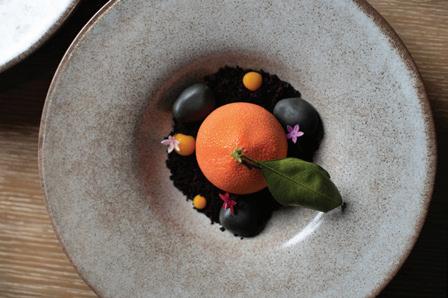
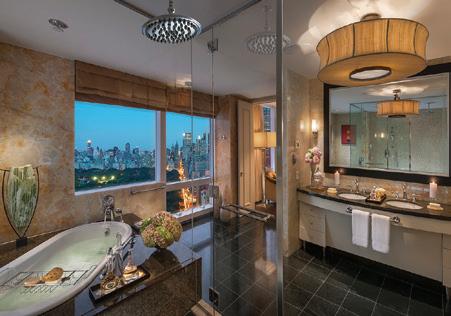
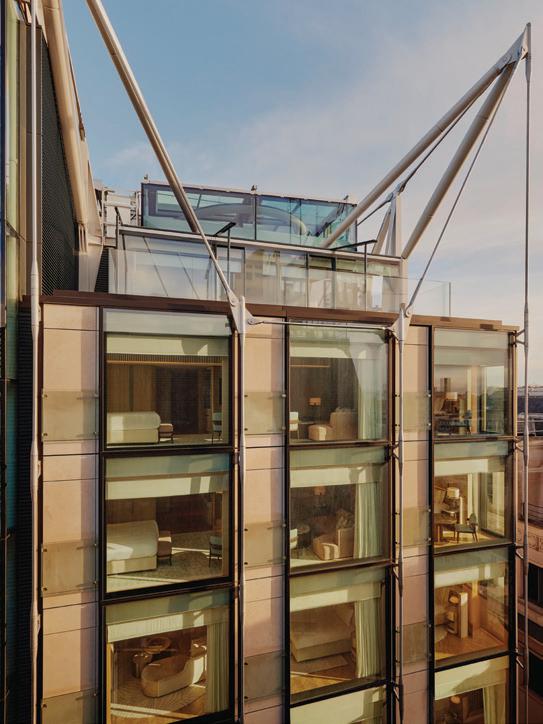
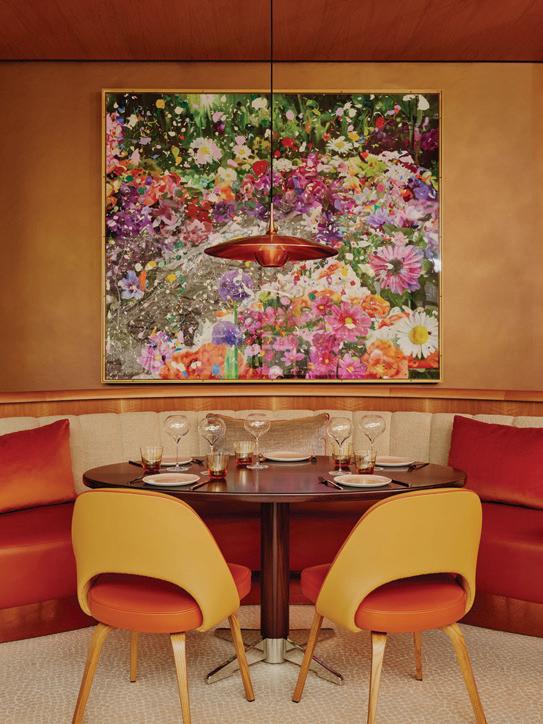
London’s latest luxury hotel opening, The Emory, is also its most unique, with a groundbreaking wellness offering
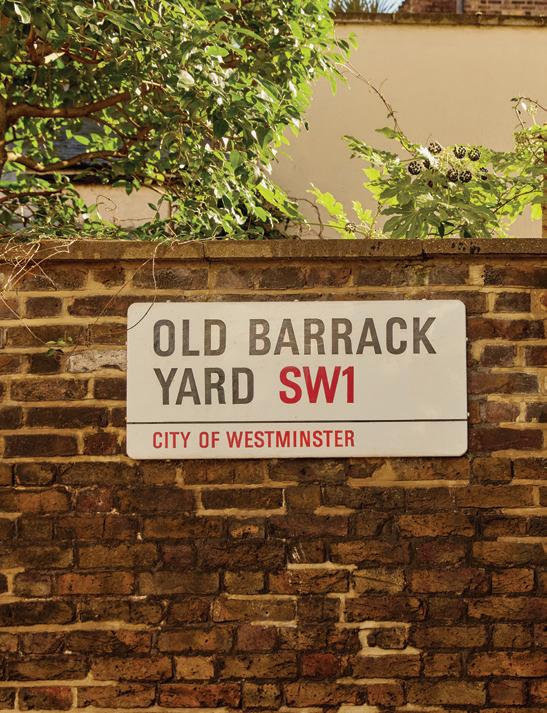
Of all the luxury hotels to open in London these past couple of years – and there’s been a glut of them – none caught our attention as much as The Emory. Not only is this the city’s first all-suite hotel, but hailing from the same stable as Claridge’s gave it instant cachet. And yet in terms of their design the two couldn’t be more different; Claridge’s an art deco icon that’s attracted well-heeled travellers for over a century, The Emory resolutely modern, its unique aesthetic – all glass and steel – coming courtesy of Richard Rogers, perhaps best known as the architect of the Pompidou Centre in Paris. And if Claridge’s is old money, The Emory is very much new. You’d have heard the term quiet luxury being banded around in fashion circles. This is the hotel version, with no lobby to ‘be seen’ in. So discreet is it that even its entrance is pretty much hidden away, barely signposted down a side street. That’s where your complimentary transfer (a very quiet, naturally, electric Mercedes) will drop you in front of a glass box reception and the first two of what are many unique artworks dotted around the hotel – both weird and wonderful sculptures created by Damien Hirst.
Hirst is one of many big names to have a hand in The Emory (you’ll also see his trademark butterflies throughout the property), and the others all best in class – Jean-Georges Vongerichten fronts an offshoot of his acclaimed

‘ So discreet is The Emory that even its entrance is pretty much hidden away’
abc kitchens; celebrity fitness guru Tracy Anderson has a studio; and the spa robes are Alice Temperley. And that’s just the tip of the iceberg.
It’s a similar story with the suites, for which a starry cast of interior designers played their part. Four of them took on two floors each – André Fu, Pierre Yves Rochon, Alexandra Champalimaud and Patricia Urquiola, while Rigby & Rigby –who have apartments at Atlantis The Royal Residences on their CV – are responsible for the rather fabulous penthouse. Each suite looks and feels like a residence and houses a bounty of little luxuries and conveniences, including a Dysonproduct laden dressing room that grows in size with that of the suite you opt for (in the smallest, it’s more functional than inviting). Views, through huge windows, are provided by leafy Hyde Park. If the ground and upper floors of the Emory are all about indulgence – JeanGeorges does guilty food (the likes of crackling fried chicken, black truffle pizza and an obligatory cheeseburger) as good as anyone, while a guest-only rooftop bar and cigar lounge are both beautifully

designed – its subterranean levels are all about wellness. Spectacularly so. Spread over four floors, which include a pool and unique café where each dish has been developed by famed nutritionist Rose Ferguson, Surrenne is a private Members’ Club devoted to wellbeing in all its forms. It’s also hands down the city’s best. Guests of The Emory are granted complimentary membership to Surrenne for the duration of their stay, which affords you access to the best names in the business – fitness classes in the springfloored studio of the aforementioned Tracy Anderson, facials devised by the likes of plastic surgery expert Dr Lara Devgan, FaceGym (which, as the name suggests, goes to work rather vigorously to telling effect on your facial muscles), and a sustainable option from Stella McCartney. What’s more, there’s an in-house physician from 3 Peaks Health (the in-the-know, go-to health company for athletes and movie stars), who can run all manner of diagnostic tests on you – including microbiome analysis – to help point the way to optimum health. It’s quite something, is Surrenne. If being a stablemate of Claridge’s gave The Emory a head start, it’s well set to win its own fine reputation. Every stay at The Emory includes a Flexjet Sikorsky S-76 helicopter oneway transfer from Farnborough, Biggin Hill and the private jet terminals at London Luton and London Stansted.

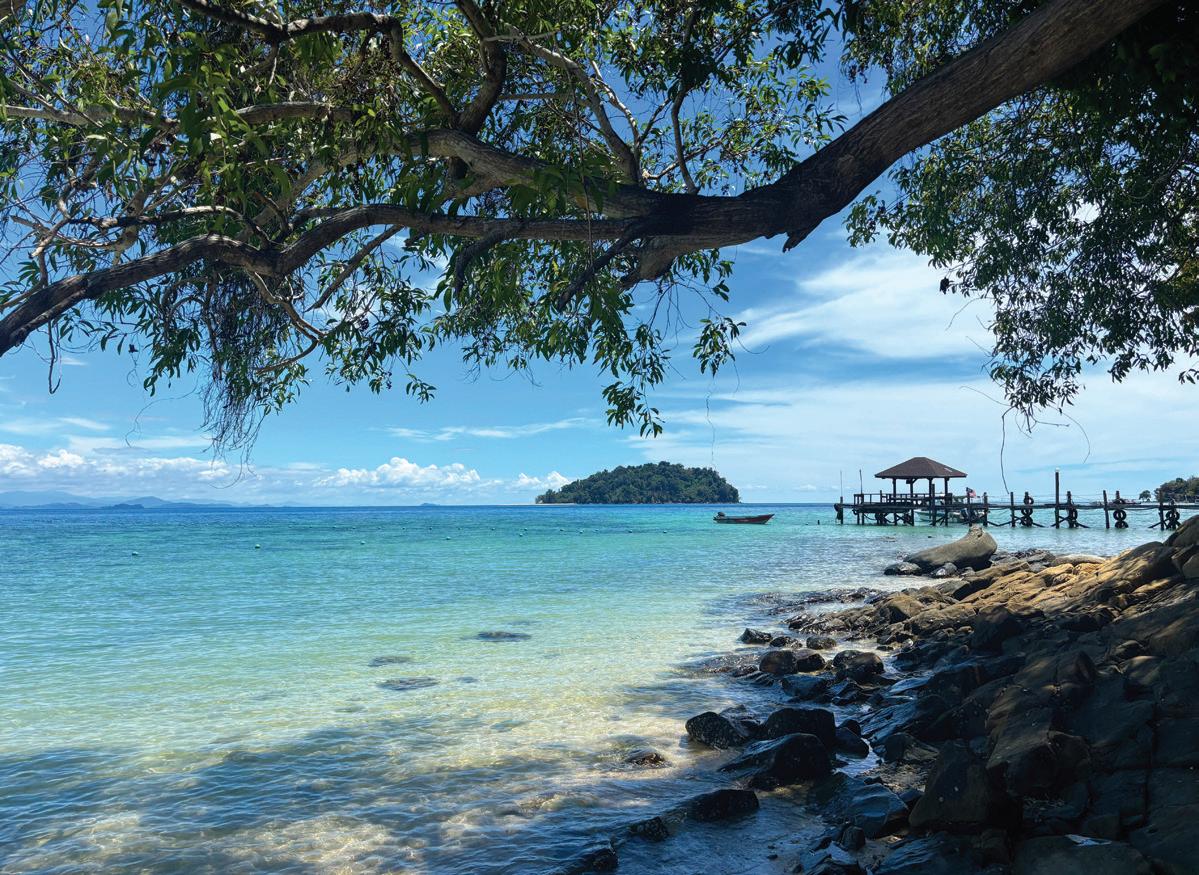
With aquamarine oceans, theatrical sunsets, rare and endangered plants and enchanting wildlife encounters in the preserved primary forests of the Danum Valley, it’s impossible not to fall under Sabah’s spell
WORDS: LYNDSEY STEVEN
Countless destinations lay claim to the title ‘world’s best sunset’, but Borneo’s Manukan Island is surely worthy of a top five spot. Witnessing the sumptuous sunset – with the last amber and gold rays of the day scattering across the South China Sea – is made all the sweeter because you’ve had to work for it.
Sutera Sanctuary Lodges on Manukan Island, the second largest island of Tunku Abdul Rahman Marine Park, is where you’ll set off from. But while the hill and beachside lodge is all about easy, breezy island style living, you’ll have to put in a little effort to conquer the steep 1.5-kilometre hike to access this privileged view on the tip of the island.
Located just off the coast of Kota
Kinabalu, the capital city of Sabah, on a UNESCO World Heritage Site, Sutera Sanctuary Lodges is the island hop before you head into the deep dense jungles of Sabah.
With a slew of awards under its belt, Sutera Sanctuary Lodges is also a member of Secret Retreats – a full-service travel concierge for leisure and business across Asia, which curates experiences that make a positive difference in the destinations you visit.
Not only is it home to Sunset Point, it is also where you’ll find two out of the 200 remaining critically endangered Eye of the Crocodile (Bruguiera hainesii) mangrove trees, which, according to leading South-East Asian plant science
and biochemistry expert Dr Jean WH Yong, is the equivalent to China having pandas. It’s also where you’ll meet Gerry – the formidable looking but friendly neighbourhood monitor lizard that hangs around resort – and a school of reef sharks that patrol the jetty.
“We don’t just offer vacations: we craft lifelong memories amidst the whispers of waves. Here you’ll ignite your adventurous spirit and redefine your idea of paradise,” Ms Eva Echague, the Assistant Resort Manager tells us.
Spring headfirst into the unknown with a parasailing escapade that lets you touch the clouds. Or take advantage of the impossibly clear seas that change colour according to mood and time of day to
play eye spy with vividly hued sergeant majors, trigger fish, parrot fish, butterfly fish, cleaner wrasse and Nemo (ocellaris clownfish).
Back on terra firma, the Hillside Villas overlooking their own stretch of private beach are perfect for honeymooners and those seeking sequestration, while families will enjoy the two-bedroom Manukan Villas which come complete with a living area and kitchen.
Not that you’re expected to cook on your vacation. At the laidback, rustic fantastic Arang Restaurant you’ll find the best of authentic Malaysian, international and fusion-inspired cuisine, with plenty of tropical fresh fruits and vegetables including distinctively pungent durian, sweet and sour mangosteens, rambutans, kangkung (water spinach) and kailan (Chinese broccoli).
Menu highlights include a skewer set where vegans, pescatarians and carnivores are all catered for with an array of colourful grilled kebabs served with a punchy satay sauce. Breakfasts are also a treat covering the full gambit of fruit, cereals, pastries, pancakes and eggs cooked any which way – as well as the option of a local breakfast of savoury rice porridge garnished with spring onions and bawang goreng (crispy fried shallots), soy sauce, sesame and tinamba (pickled vegetables).
Should the heavens decide to open, the resort also has an indoor restaurant which features a cosy alcove with low seating – ideal for board games. The resident three-man band are always on standby to take dinnertime requests and can pull off a sterling rendition of ‘Ring of Fire.’
Suitably fortified and refreshed, it’s time to explore Sabah which contains some of the world’s oldest rainforests, teaming with animal and plant species. Home to more than 220 species of mammals, including the alluring orangutan – the largest arboreal (tree hanging) animals in the world – Borneo has long drawn scientists to its shores to study its wonderfully rich biodiversity.
Nestled in the Lower KinabatanganSegama Wetlands (LKSW) – globally recognised as an important wetland area – Kinabatangan Wetlands Resort is Borneo’s most upmarket forest sanctuary, a stunning timber-built resort hidden amongst ancient mangrove trees. It is also one of the few locations you’ll spot Proboscis monkeys, the long-nosed
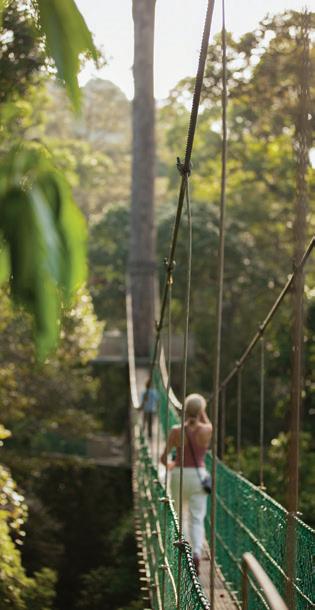
‘ The sense of wonder and connectedness with nature is incredibe ’
primates that come out to play during your river cruises.
No journey to this part of the world should forgo the unique opportunity to check into the Borneo Rainforest Lodge. Nestled within 43,800 hectares of the Danum Valley Conservation Area, the home of a 130-million-year-old virgin rainforest, the sense of wonder and connectedness with nature that it elicits is unlike any other you’ll experience. With rainforest and canopy walks, river tubing, animal and bird spotting and night safaris, the knowledge and passion of the guides make your stay all the more special.
If it’s good enough for Dame Judi Dench… the revered actress filmed much of her Wild Borneo Adventure documentary here and even has a tree named after her. In 2025 the Borneo Rainforest Lodge will add six deluxe three-story triplexes that come complete with their own private butler and guide. What more reason do you need to visit?


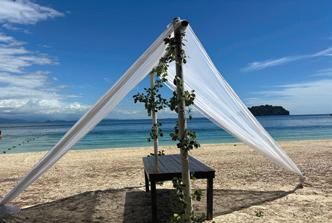



HAUTE COUTURE DESIGNER
The only limits you have in life are those you place on yourself. No matter what, always believe in yourself. That’s the best piece of advice I’ve ever received.
There have been so many wonderful moments throughout my career that it feels near impossible to choose just one single achievement as my greatest. I feel so fortunate and grateful to be able to say that. But, to name a few, being the first UK-based designer in over 100 years to be invited to show during Paris Haute Couture Week; beginning anew with the launch of my eponymous brand last year; but undoubtedly, and most importantly, becoming a mother to two beautiful daughters.
A lesson I learned the hard way was the importance of not only staying true to yourself and your own vision but surrounding yourself with the right people who share that vision – and who will support you every step along the way, regardless of the obstacles.
I would like to have a talent for singing. Not because I want to be a singer, but because I love music and I always have something playing. It brings so much happiness to my soul.
If I could change one thing about myself it would be that I sometimes find it difficult to narrow my focus, as I am often brimming with thoughts, designs and new ideas that take me in different directions. My new collections begin from hundreds of sketches before I begin to pare them back – which is quite difficult to do! But creating is what I love doing most. In the end, we always get to where we need to be.
If I could tell my younger self something it would be to stay strong in your convictions and never doubt your instincts.
I admire women who strive for greatness and success. Women such as my clients, incredible artists, or otherwise inspirational trailblazers such as Beyoncé, Michelle Obama and Angelina Jolie.
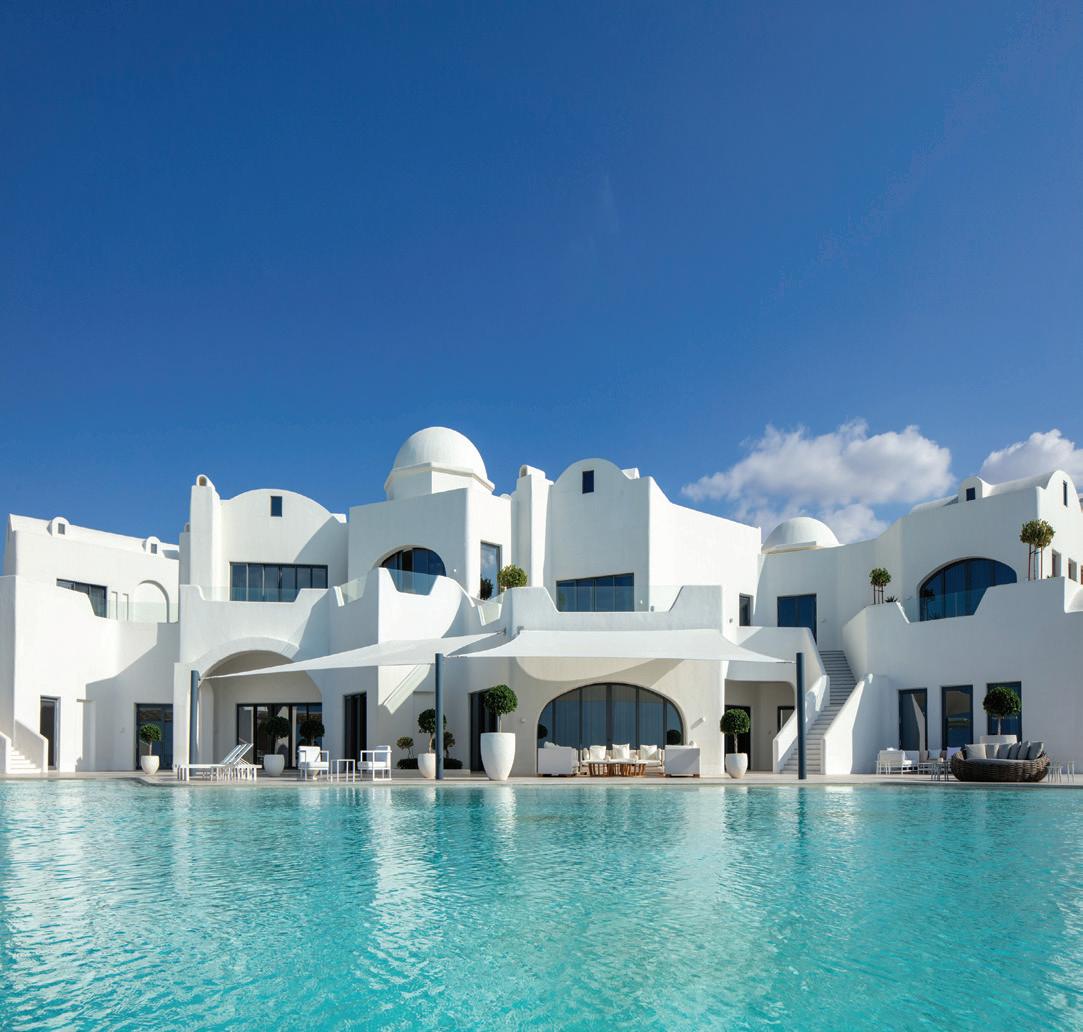
Discover an intimate hideaway halfway between Dubai and Abu Dhabi on a picturesque coastline. Inspired by the charm of Greek islands, every room offers stunning sea views and complete privacy. Indulge in unparalleled luxury with elevated hospitality, exclusive dining, and rejuvenating spa services at our adult-only resort. Just 25 minutes from Al Maktoum International Airport, experience serene splendour at Anantara Santorini Abu Dhabi Retreat.
